When it comes to history and culture, Granada is arguably the most excellent city in Andalusia – so, por favor, grant me the pleasure to guide you to the most glorious sites’n’landmarks.
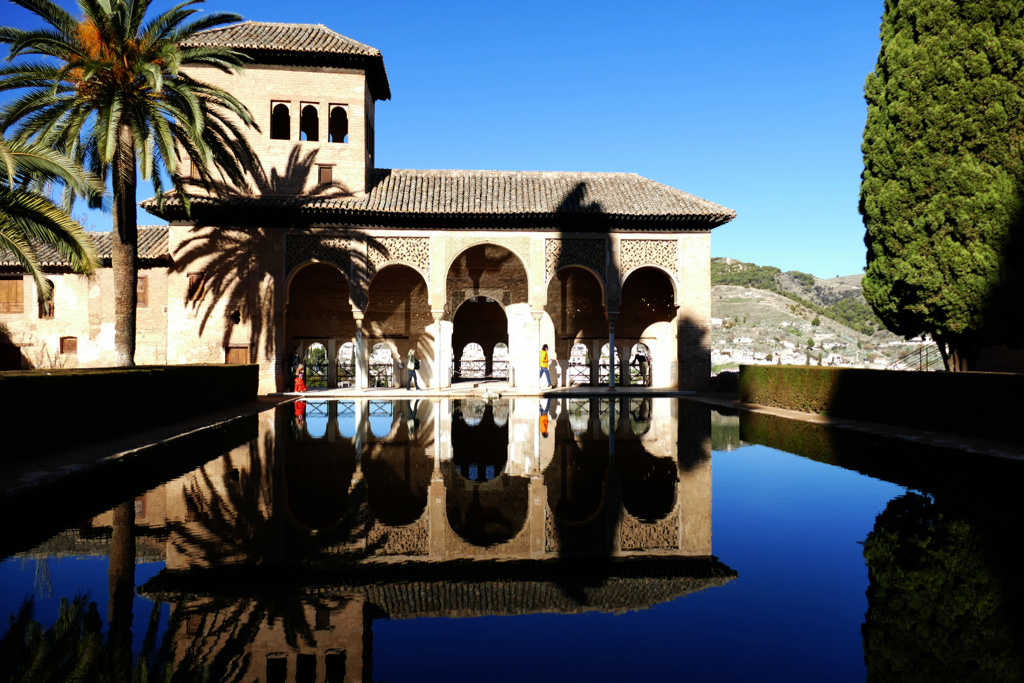
Granada – The Heart And Soul of Andalusia
I must say that on my road trip through Andalusia, Granada was the city that probably stunned me the most. Actually, it wasn’t its grandezza – which is undoubtedly there. However, grandezza I did expect.
No, actually, it was the exact opposite: I was taken by surprise by all the young, hip crowds in the streets, on the buses, in every café’n’bar. Well, Granada is first and foremost a university city. Of a population of about 240,000 people, about a third are students, but also lecturers, researchers, and administrative staff at the university. I had no clue.
As a matter of fact, Granada’s university was founded in 1531 by Emperor Charles V and is Spain’s fourth-largest university today. Apart from the city of Granada, it also maintains campuses in Spain’s North African enclaves Ceuta and Melilla. Interestingly, before tourism kicked in after the end of Franco’s dictatorship, the university was one of Granada’s main sources of income, especially in the 20th century.

But it’s not only the students hanging out on squares and rushing through picturesque alleys. Especially on the Albaicín, I ran into flocks of hippies, crafting jewelry, playing the guitar, and just having a good time. If you’re going to Granada, be sure to wear some flowers in your hair?!? What brought them to Granada of all places?
No matter what, they are adding to the friendly and relaxed vibe of the city’s less touristy corners.
Howsoever, looking back at Granada’s ever-changing history, the vibe hadn’t been always as cool’n’relaxed as it is today.
So let’s just take…
A Quick Look at Granada’s History
After the collapse of the Roman Empire, the area first came under the influence of the North African Empire of the Vandals. Romans took over for several decades in 534. Eventually, it belonged to the Iberian Empire of the Visigoths from the beginning of the 7th century.
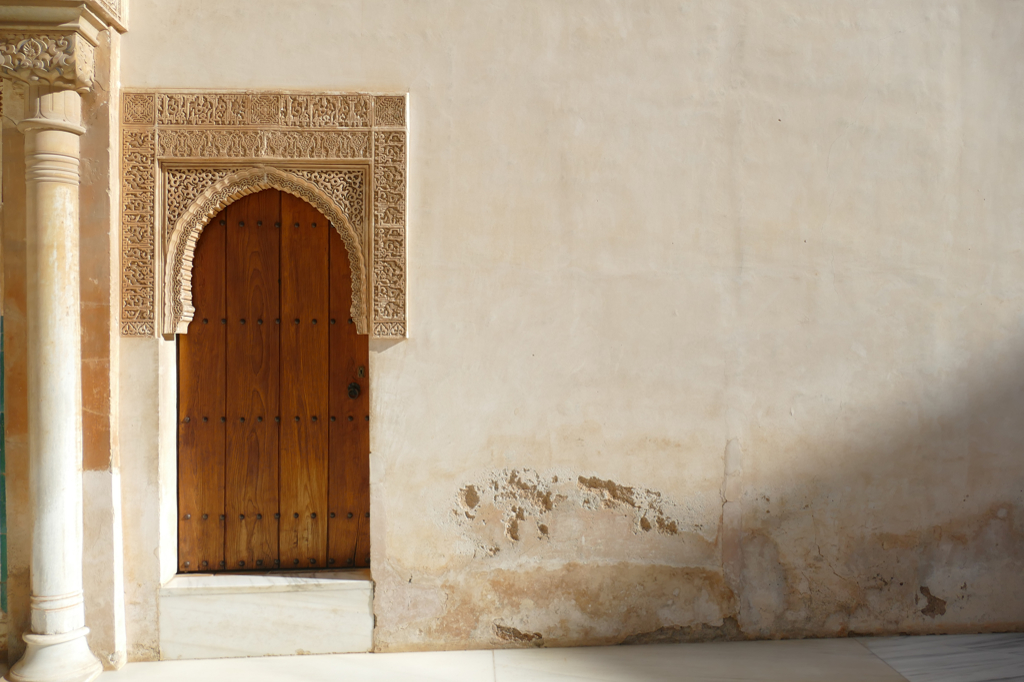
After the fall of the Córdoba caliphate, the Berber clan chief Zawi ibn Ziri seized control in the province. In 1012, he made Granada the center of the Zīrī dynasty. In 1090, however, the Almoravids took over. Consequently, after the expulsion of the Almohads, the city became the capital of the Nasrid Sultanate from 1238 until the Reconquista.
In 1066, a massacre of the Jewish vizier and most of the city’s Jewish population took place in Granada. Although such bloodbaths were by no means the norm in Moorish Andalusia, it is considered the first European pogrom against Jews.
Reconquista
In 1492, the Catholic Kings Isabella I of Castile and Ferdinand II of Aragon subdued the last Nasrid ruler. Although there was an agreement that allowed the Moorish population to practice their religion freely. Nevertheless, the Nasrids had to leave Granada.
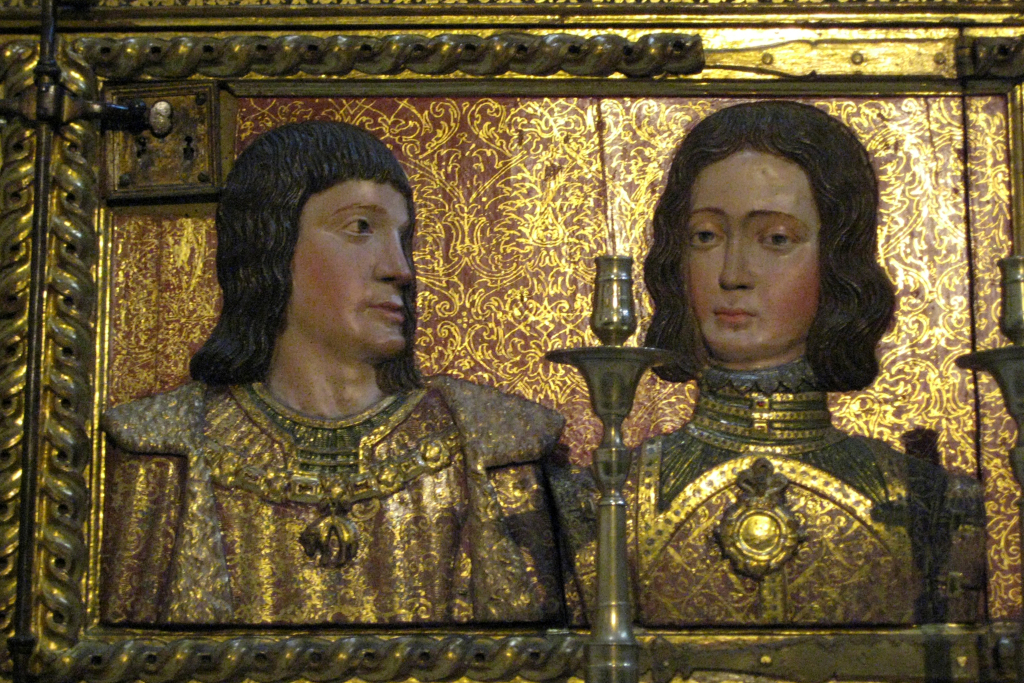
(Photo: user:shakko, Capilla real reliquary left03, trimmed 3:2, CC BY-SA 3.0)
In 1499, at the behest of Archbishop Jiménez de Cisneros of Toledo, all books on Islamic theology and philosophy, but also history as well as science went up in flames on Granada’s market square. Throughout these events, there was also a pogrom against all non-Christian inhabitants. The century-old Jewish quarter was largely destroyed.
The remaining Muslims fought against their oppression by the Catholic rulers. Consequently, they were first banned to other parts of the Iberian Peninsula and eventually expelled to North Africa in the early 17th century. Due to this cultural seclusion, Granada fell into economic insignificance.
Today, about 15,000 Muslims live in Granada. However, about ten percent of them are Spanish converts.
Visiting Granada’s Breathtaking Landmarks
I’m not even trying to be original: The most important landmark to visit in Granada is – to no surprise – the Alhambra, the ancient Moorish fortress on top of the Sabika hill. However, there are other breathtakingly beautiful structures and views that will just blow you away.
I’ve divided my itinerary into five main areas, and it probably won’t be any surprise that four of them are on hills.
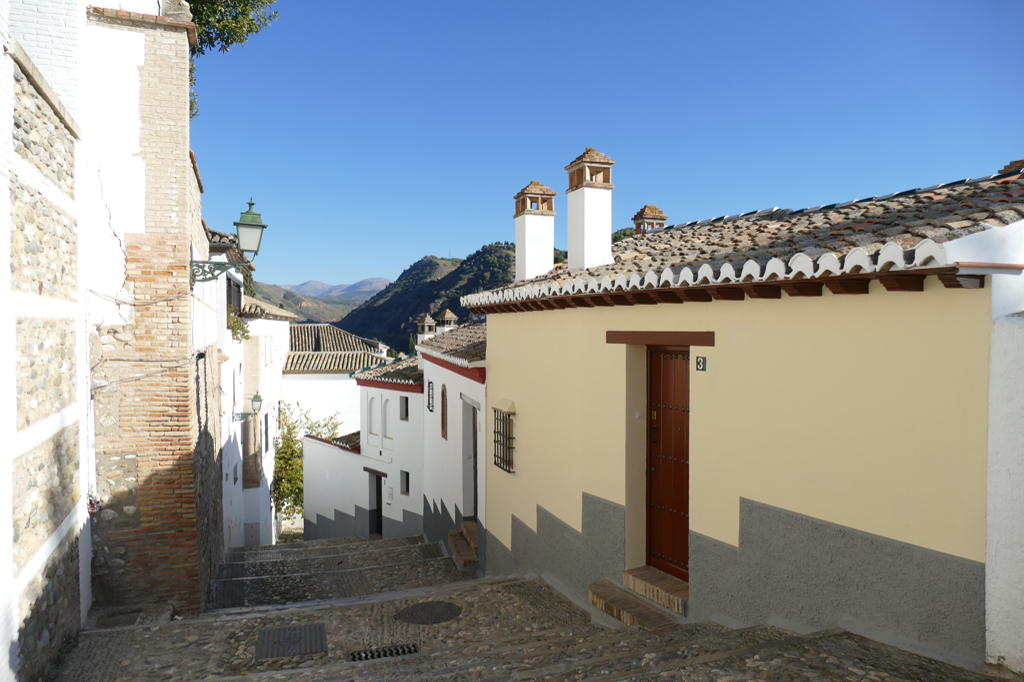
While usually panoramic views take a toll on your fitness, in Granada, small public buses wind their way up even to some rather secluded spots. This way, you can enjoy the most fantastic views of the city without breaking a sweat.
Mind you, basically, all of these jewels are way up high on mountains. So although I’m a big advocate of exploring cities walking, Granada is definitely an exception to the rule. Since Granada is also the only city in Spain where getting a tourist pass really makes sense, you’re all set as this pass also includes nine trips on the city’s comprehensive bus system.
So: All systems go!
Granada Central
Let’s define the center of Granada as the area between the Avenida de la Constitución in the north, the river Genil in the South, the Circunvalación de Granada in the west, and the Sabika Hill in the west. This part is a mix of historic and new and definitely the bustling heart of the city. There are uncountable shops, restaurants, bars, and services situated along broad streets as well as narrow cobblestone alleys. But make sure to not miss the highlights I’m introducing in this section.
Catedral de Granada
Obviously, we are beginning with the most solemn building is definitely Granada’s Cathedral. This sublime construction from the 16th century is actually Spain’s second-largest cathedral.
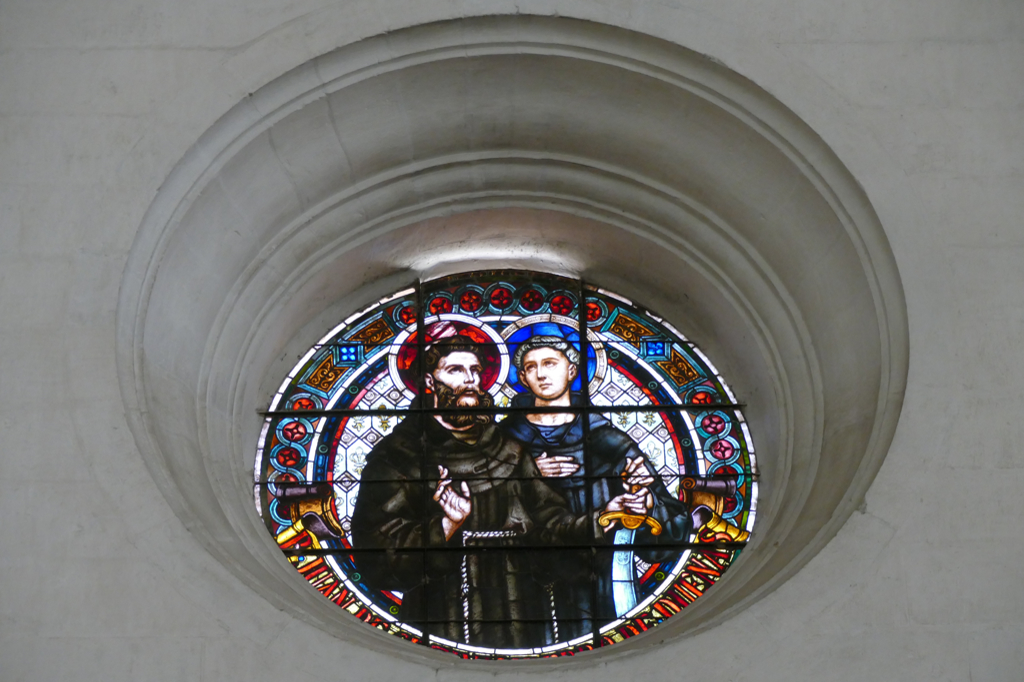
As in basically all other Andalusian cities, the Cathedral was constructed on the site of a former Mosque. It was laid out with a Gothic foundation but then built in a Renaissance style. Finally, it was decorated with Baroque elements.
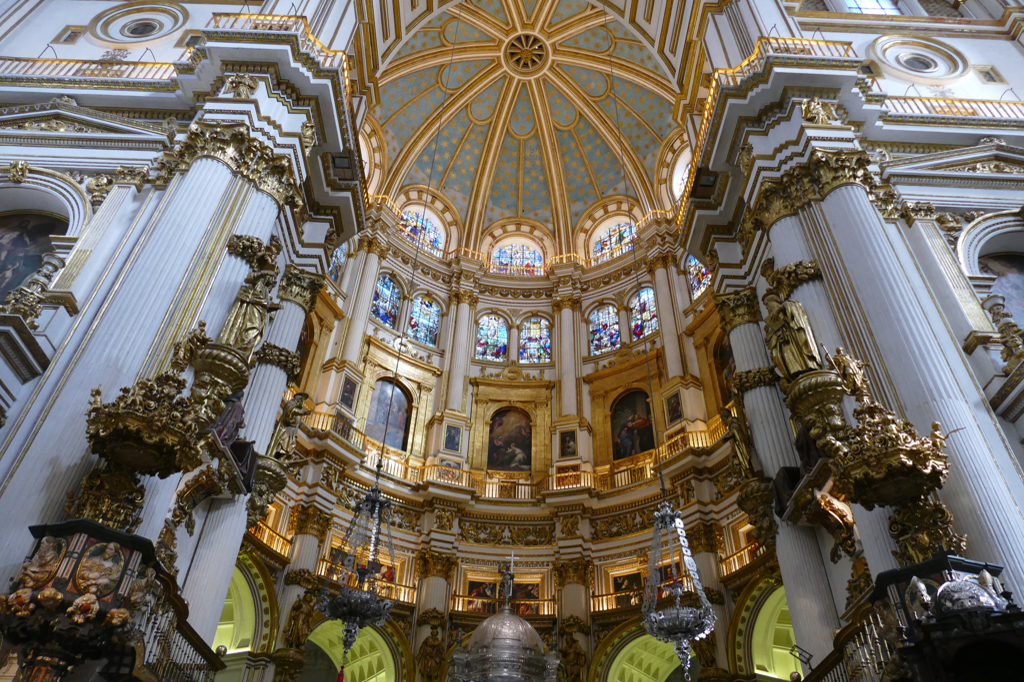
There is a row of chapels containing exquisite artwork. The sacristy retains paintings, mirrors, and furnishings. However, the most spectacular part is the Capilla Mayor sanctuary with a magnificent domed ceiling.
Plan Your Visit:
The Cathedral is open for touristy visits Monday to Saturday from 10.45 a. m. till 1.30 p. m. and in the afternoon from 4 p. m. to 8 p. m. and Sundays only from 4 p. m. till 8 p. m. During the winter months from September to February, they are closing already at 7 p. m. The entrance fee is 5 €uros, however, it’s included in the Granada Card.
Capilla Real
The Capilla Real, hence, the Royal Chapel, is standing on the southeast corner of the Cathedral. The building which was finished in the 18th century houses the remains of the Catholic Monarchs Ferdinand II and Isabella of Castile and those of their daughter Joan of Castile and son-in-law the Habsburg Philip the Handsome. Also, Crown Prince Miguel da Paz, who died at the age of two, is resting here. Although the chapel was constructed in the Gothic style, the marble tombstones are made in the Renaissance style.

Apart from elaborated artwork in the chapel, there is also a museum with a number of objects symbolizing Ferdinand and Isabel’s rule, including insignia like the crown, scepter, and Ferdinand’s sword.
In the sacristy museum is a small but exquisite exhibition including works by the Renaissance masters Botticelli and Perugino as well as the old Flemish masters Rogier van der Weyden and Hans Memling.
Plan Your Visit:
The Royal Chapel can be visited Monday to Saturday from 10.15 a. m. till 1.30 p. m. and in the afternoon from 3.30 p. m. to 6.30 p. m. and Sundays from 11 a. m. till 1.30 p. m. and in the afternoon from 3.30 p. m. to 6.30 p. m. From March till August, they are closing one hour later. The general entrance fee is 5 €uros, however, it’s included in the Granada Card.
To this date, in the Cathedral’s vicinity are actually still testimonies of Moorish Granada:
Palacio de la Madraza
The Madraza de Granada was the University of Moorish Granada. This makes total sense since madraza is a school in Arabic. Sultan Yusuf I founded this institution in 1349. Law, medicine, and mathematics were taught here.
Today the building is part of the Universidad de Granada and used for cultural purposes. Also, it houses the Real Academia de Bellas Artes de Nuestra Señora de las Angustias, the Royal Academy of Fine Arts.
In former times, the Madraza stood next to the Great Mosque of Granada, while it was still where today’s Cathedral is standing.
Plan Your Visit:
The Palace can be visited Monday to Friday from 9 a. m. till 6 p. m. and on weekends between 11 a. m. and 2 p. m. for an entrance fee of only 2 €uros.
La Alcaicería
South of the Cathedral is a labyrinth of alleyways. Here used to be the Alcaicería, a term used for markets for luxury products like silk, carpets, silver, gold, and the like. As a matter of fact, the Alcaicerías in Granada, Málaga, and Almería brought the Nasrid emirs huge revenues.
Although the market initially prevailed even after the Reconquista, King Philipp II had it shut down during his reign in the 16th century. Then, in 1850, a fire destroyed what was left.
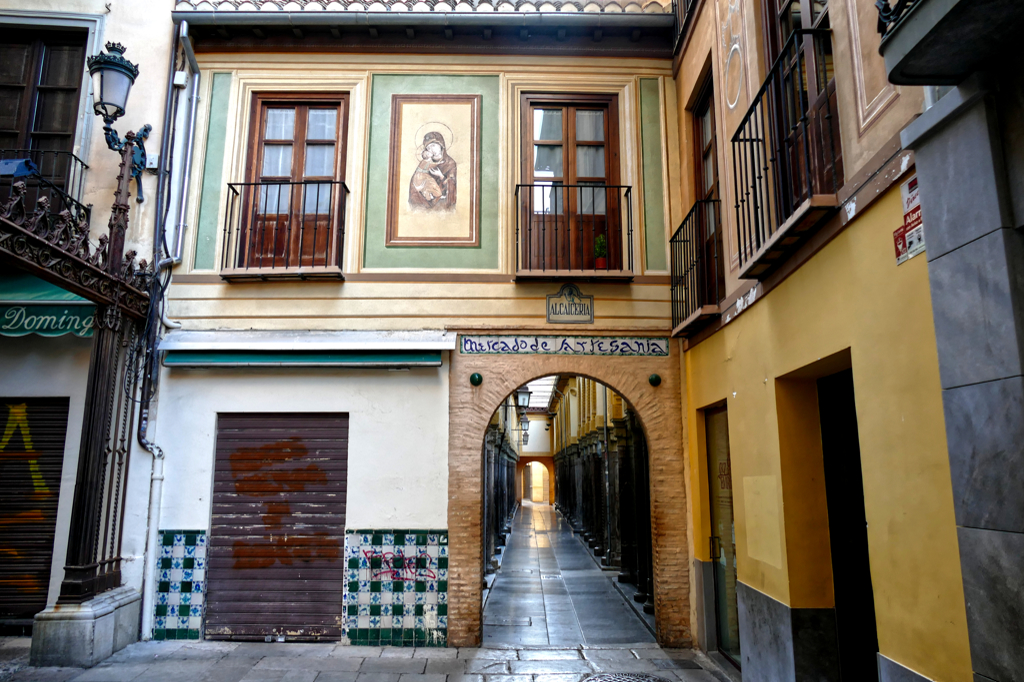
Today’s market was rebuilt in the late 19th century. Its souvenir stores are clearly aimed at tourists. However, the architecture of the Moorish-style archways is worth a short visit.
The Alcaicería opens from Monday to Saturday from 10 a. m. to 9 p. m. and on Sundays between 10.30 a. m. and 2.30 p. m.
Corral del Carbón
The Corral del Carbón, or coal court in English, is a former Nasrid caravansary built in the 14th century. After the Reconquista, this place was transformed into a theater. Eventually, it became a yard for charcoal merchants. It is probably Granada’s oldest structure and the only conserved caravansary in Spain.
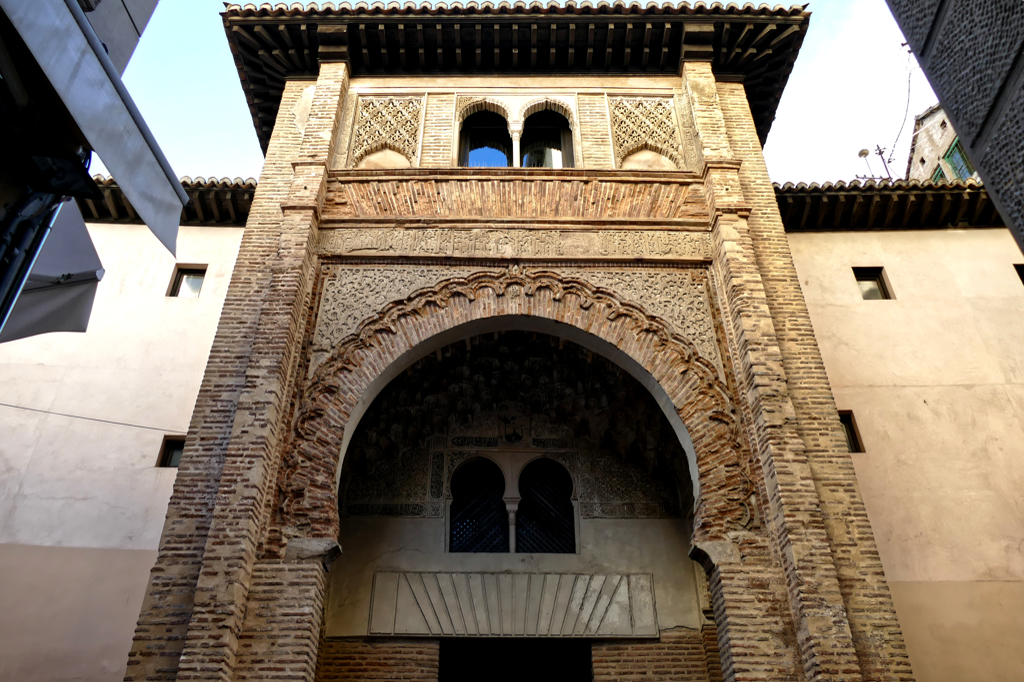
Today, it houses a box office. The courtyard can be accessed every day between 10 a. m. and 8 p. m.
Plaza Nueva and Plaza de Santa Ana
As Plaza Nueva is Granada’s oldest square, it used to be the epicenter of the city’s everyday life. On its east side, it merges into the Plaza de Santa Ana.
Between and around these squares is a good number of restaurants and bars. Nevertheless, there are also some historically important buildings here.
Palacio de la Real Chancillería
The palace was completed in 1587 as the seat of the court established by Isabel I of Castile and even contained a prison.
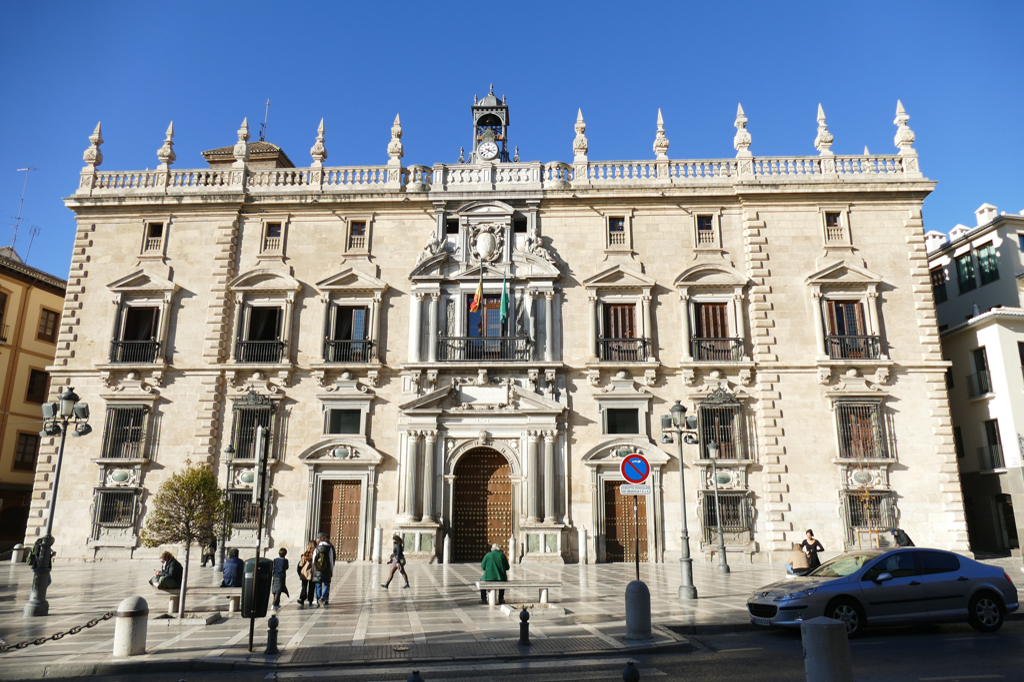
Francisco del Castillo el Mozo designed the gorgeous façade. Due to its extraordinary Mannerist architecture, the building has been classified as a historical monument.
Today, it’s the seat of the Superior Court of Justice of Andalusia.
Iglesia de San Gil y Santa Ana
The church of San Gil and Santa Ana was constructed from bricks in 1537. The tower was added only between 1561 and 1563. The building combines the styles of the Renaissance and Mudejar, hence, Christian architecture which is adorned with Islamic patterns.
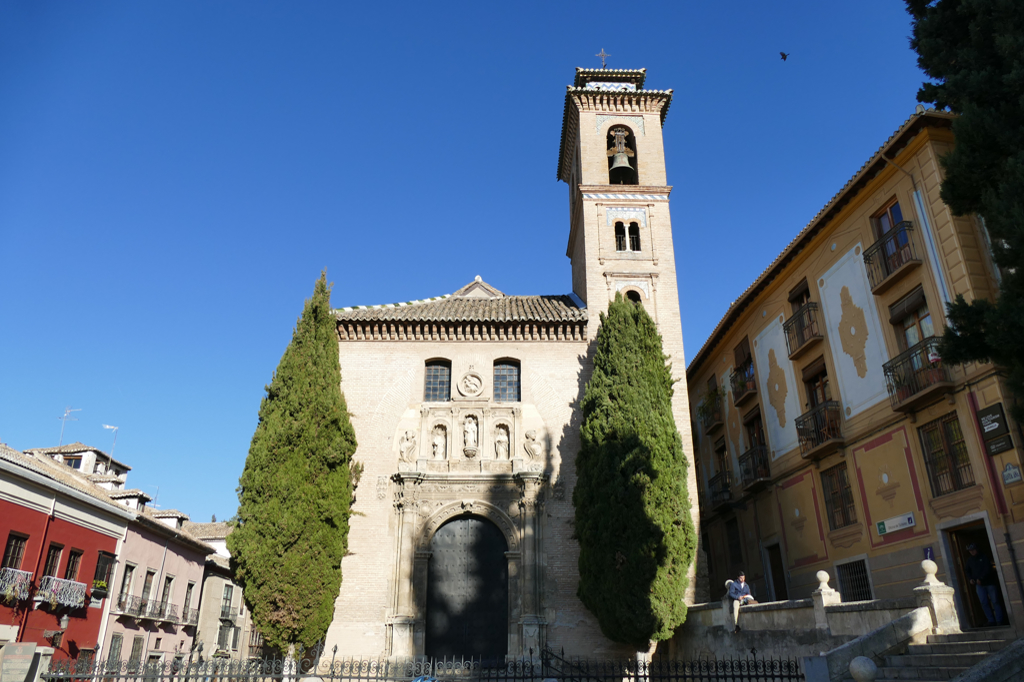
When the parish was abolished in 1869, the church of Santa Ana became also the seat of San Gil. Since 1948, the parish has been called San Gil and Santa Ana.
The church is open for touristy visits from Tuesday to Sunday between 11 a. m. and 1.30 p. m.
Basílica de San Juan de Dios
To get from the Plaza Nueva to the Basílica of San Juan de Dios, you have to walk back to the Cathedral and then up north. I recommend you take the Calle San Jerónimo since there are a couple of truly precious buildings and squares left and right along the way. You might want to stop at the Plaza de la Universidad to admire the Parroquia de Santos Justo y Pastor as well as the Convento de la Encarnación de Granada. Finally, turn right at the Santuario de Nuestra Señora del Perpetuo Socorro into the Calle San Juan de Dios.
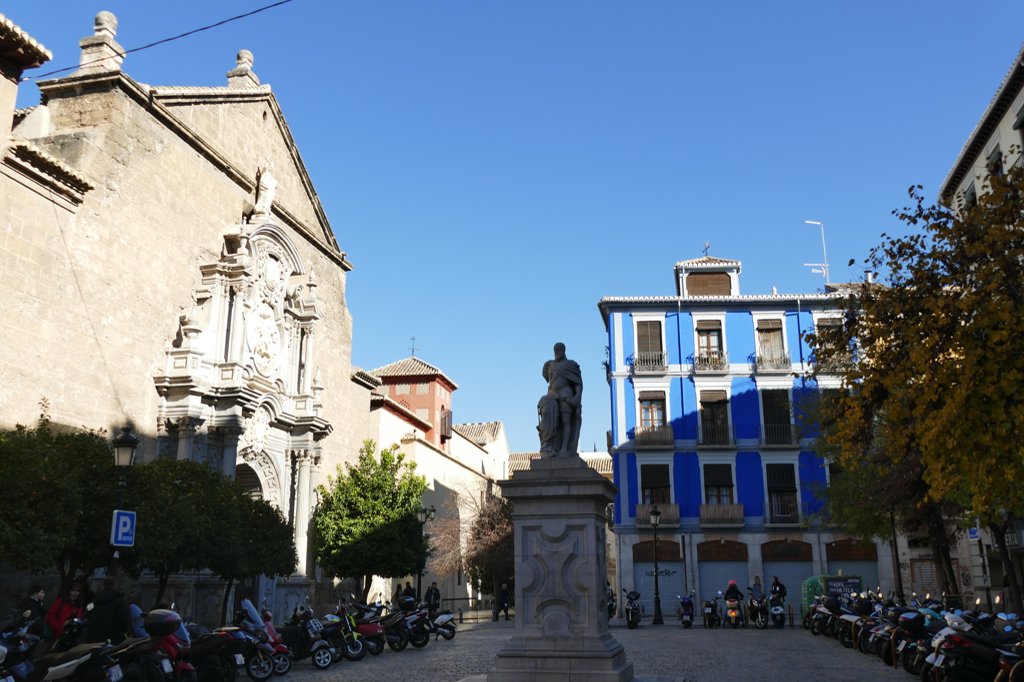
In the 18th century, Prior Alonso de Jesús Ortega of the Order of the Brothers of Charity of St. John of God commissioned the construction as a home for the remains of the order’s founder John of God.
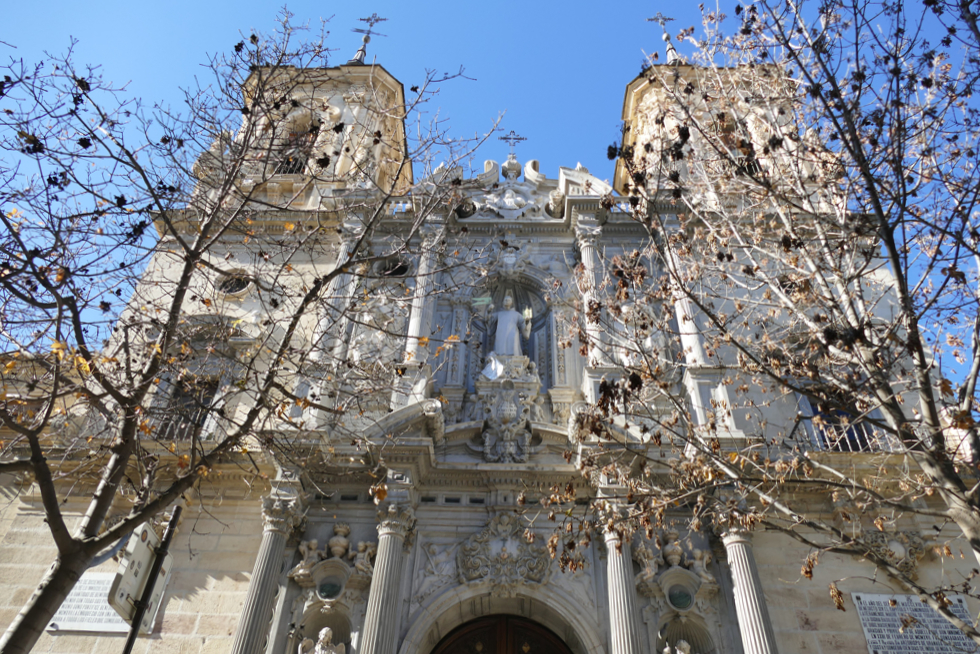
The building was made from stone and brick in the Baroque style. The façade is framed by slate-topped towers.
Don’t let the church’s rather unspectacular exterior fool you. Inside, it’s truly glorious and gilded all around. Statues, paintings, wood carvings, large organs, and a lavish altar will certainly impress you.
Plan Your Visit:
The Basílica is open for touristy visits from Monday to Saturday between 10 a. m. and 7 p. m. for an admission fee of 5 €uros.
Jardines del Triunfo
The entire area to the right of today’s Jardines del Triunfo was urbanized in the 17th century. This transformed the place and its surroundings into one of the most important neighborhoods in the city.
Between 1810 and 1812, Granada was occupied by French troops during the Peninsular War. During this time, the occupiers’ Spanish opponents were publically hanged or shot in the square. Eventually, it continued to be the site of public executions until 1840.
Nevertheless, in 1856, Mayor D. Manuel Gadeo y Subiza altered the infamous spot into a park.
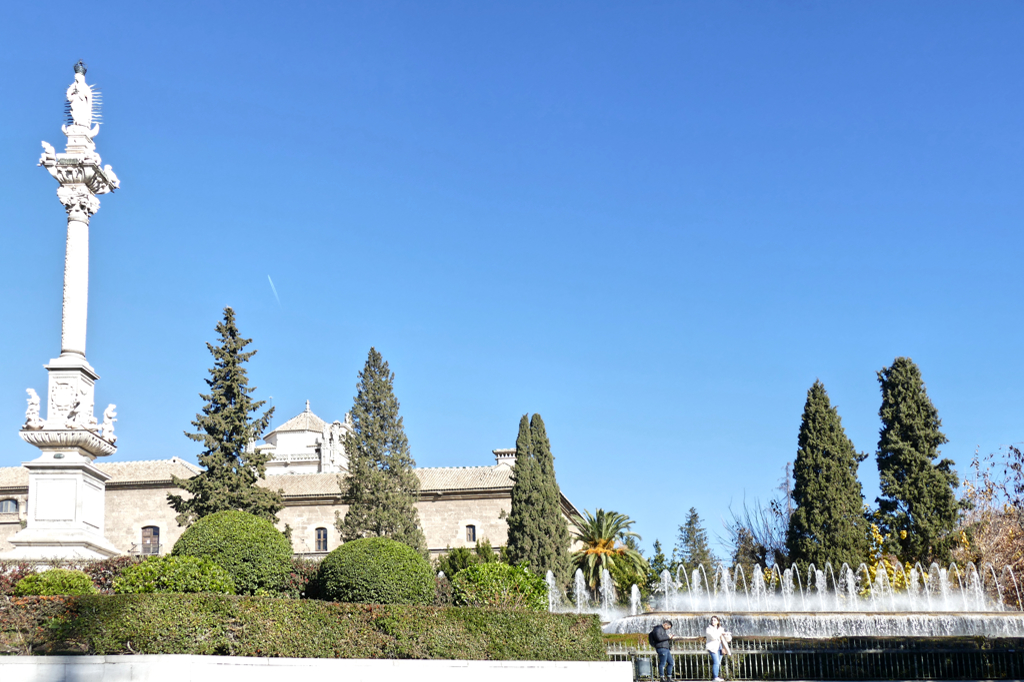
Due to its central location, the Plaza del Triunfo basically connects all the sections introduced in this post with each other. Hence, it’s really easy to add to either of them. And you definitely should include it in your itinerary since apart from being a lush garden, there are some grand monuments around.
The park is open every day from 8 a. m. to 10 p. m.
Hospital Real
The royal hospital is a former infirmary. After the conquest of Granada in 1492, the Catholic Monarchs commissioned some stately buildings in the city. Among them were the Royal Chapel and the Royal Hospital. The latter was constructed on an old Muslim cemetery in 1504. Initially, it served the poor and soldiers who had been injured in the Reconquista.
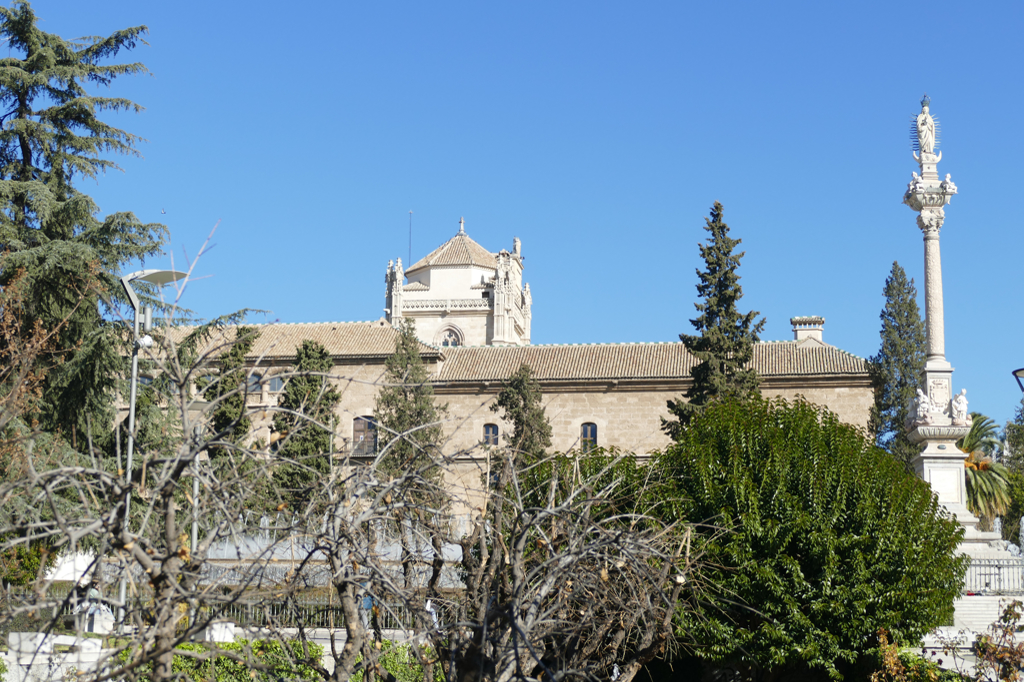
Currently, it houses the rectorate of Granada’s university including the library and the central management services.
Fray Leopoldo de Alpandeire and the Parroquia De La Inmaculada
Leopoldo de Alpandeire, born in 1864 in Alpandeire in the province of Málaga, was a Capuchin monk. As he was known for his humble life and for helping those in need, he was beatified in 2010.
After he died in Granada in 1956, his relics were rested to peace in a crypt in Granada’s Capuchin Church.
Fray Leopoldo’s crypt is the second-most visited monument in the city. However, the greater part of the 60,000 monthly visitors is locals.
Besides the relics, there is a series of paintings by Hugolino de Belluno depicting Brother Leopoldo’s life and a small museum.
The crypt is open every day from 9.30 a. m. till 8 p. m. with a lunch break from 1.15 p. m. to 4.30 p. m.
Casa-Museo and Parque Federico García Lorca
Federico del Sagrado Corazón de Jesús García Lorca
Obviously, Lorca’s poetry can be only insufficiently translated – this is every piece of writing’s fate. Hence, the virtuous articulateness in his mother tongue might be lost on you. Albeit, far more challenging for foreign readers will be to grasp Lorca’s works regarding the socio-cultural background. After all, Federico García Lorca rejuvenized the Spanish theatre in the 20th century.
Lorca was born and raised near Granada in 1898. In 1909, the educated and cultured family moved to a townhouse in Granada, where Federico attended high school and university. Here he met local poets and undertook study trips. He travelled all the way to New York and also visited Cuba in 1930.
When the far-right nationalists came to power, Lorca signed several anti-fascist manifestos. Then, three days after the beginning of the Spanish Civil War, the fascist putschists abducted Lorca and shot him on August 19, 1936. They buried him hastily on the side of the road. To this date, the location of Federico García Lorca’s grave has remained unknown.
Huerta de San Vicente
Amidst the lovely Parque Federico García Lorca is the Huerta de San Vicente. This former home is now a museum that still houses the original furnishings from when the Lorca family lived here in the 1920s and 1930s. Today’s public park around the house was once their private estate.
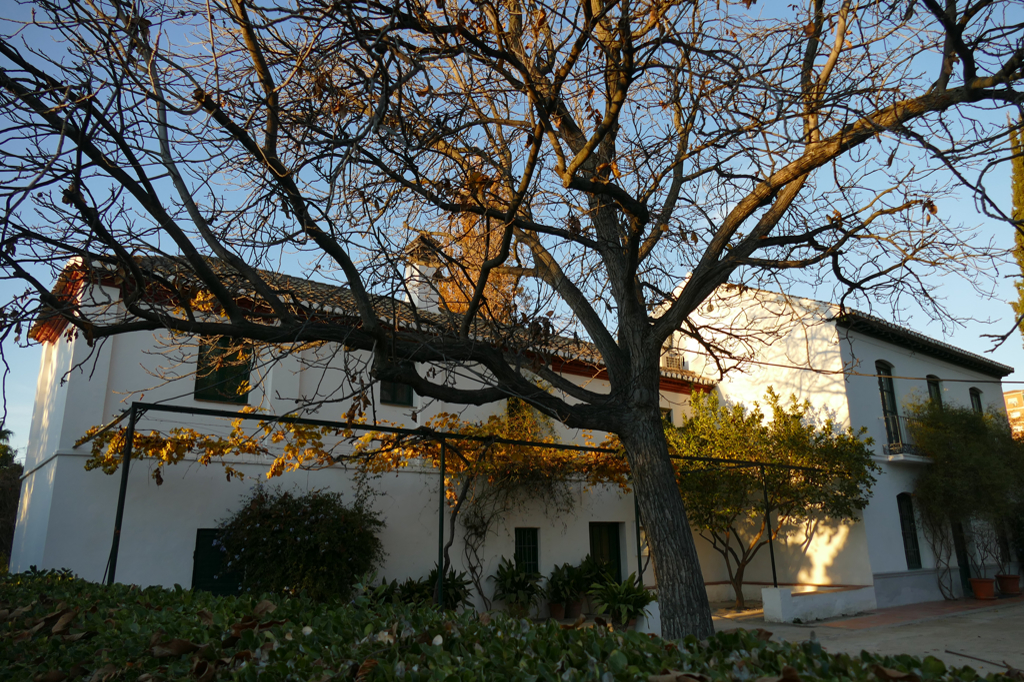
Normally, the Huerta de San Vicente can be visited, however, at this moment – in the summer of 2023 – it is closed due to renovation. Please consult their website to see when they re-open. Obviously, you can still see the house’s outside and enjoy the surrounding gardens.
Sabika Hill
The Alhambra
The world-famous Alhambra crowns the top of the Sabika hill. The medieval complex is one of the top attractions not only in Granada, but in all of Spain. As the last Moorish stronghold in Europe, the Alhambra still shows the splendor of Moorish culture and society in Andalusia.
The Alhambra was a citadel and fortress, but also a palace and the home of the Nasrid sultans, soldiers, servants, and administrators in the 13th to 14th centuries. Northeast of the Alhambra is the Palacio de Generalife. This was the summer palace and country estate of the Nasrid rulers.
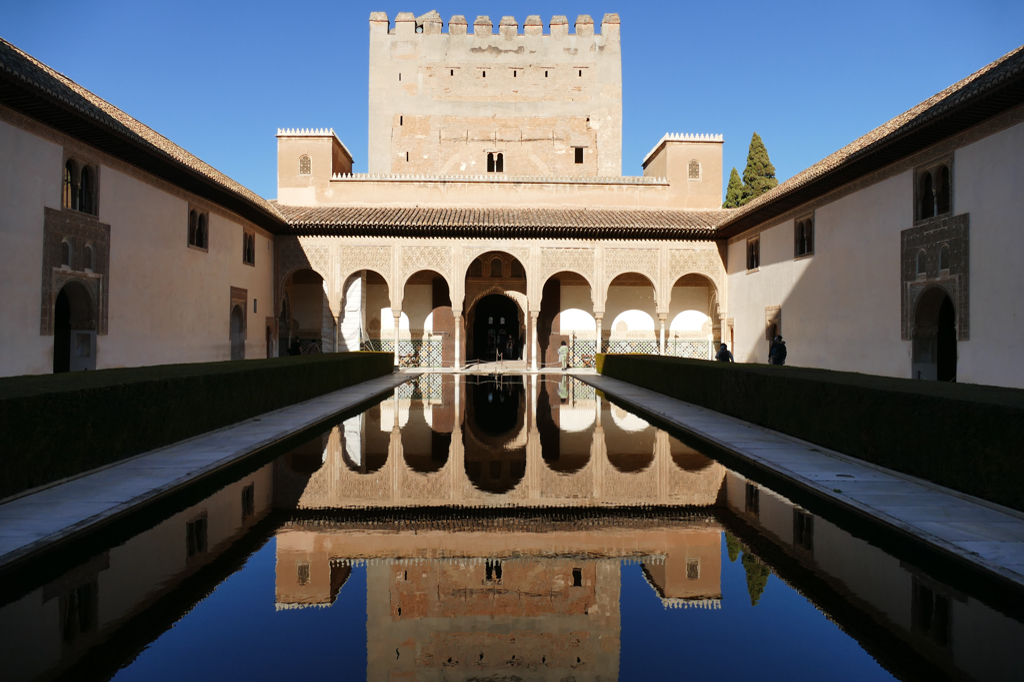
Apart from the Moorish part, there are further remarkable buildings on the premises. They stem from various periods.
The most momentous one is the Renaissance Palace of Charles V. It houses the Alhambra Museum and the Museum of Fine Art. In the 15th century, the Convento de San Francisco was added. A Mosque was transformed into the Iglesia de Santa María de la Encarnación in the early 17th century. However, there are far too many structures, walls, and towers to list them all.
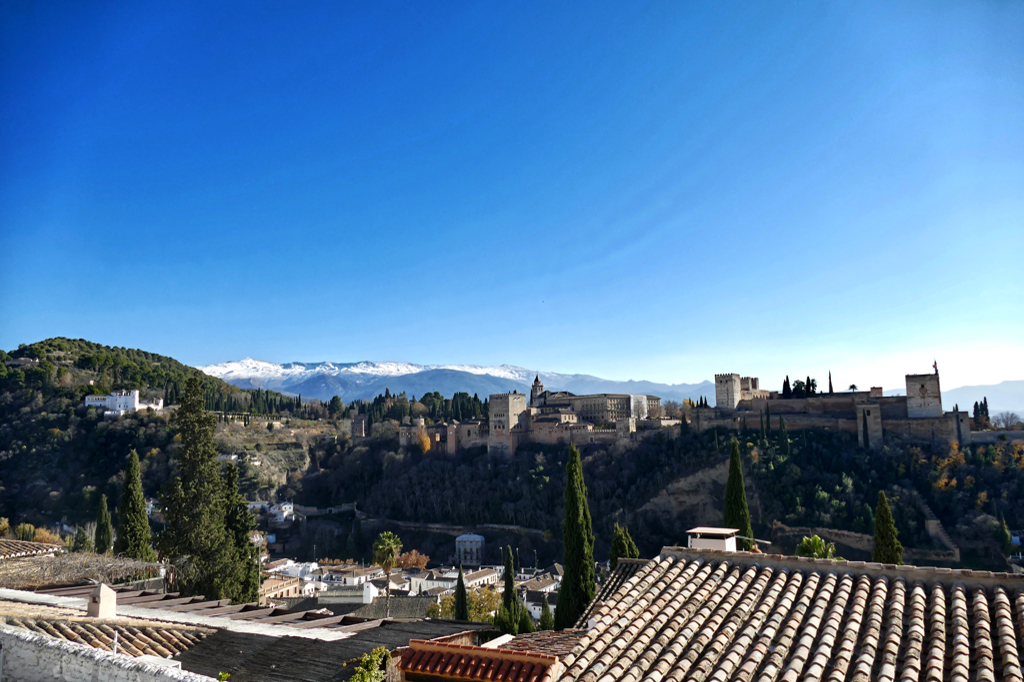
Apart from the Alhambra’s own splendor, the complex will enchant you with spectacular views of the city and its surroundings.
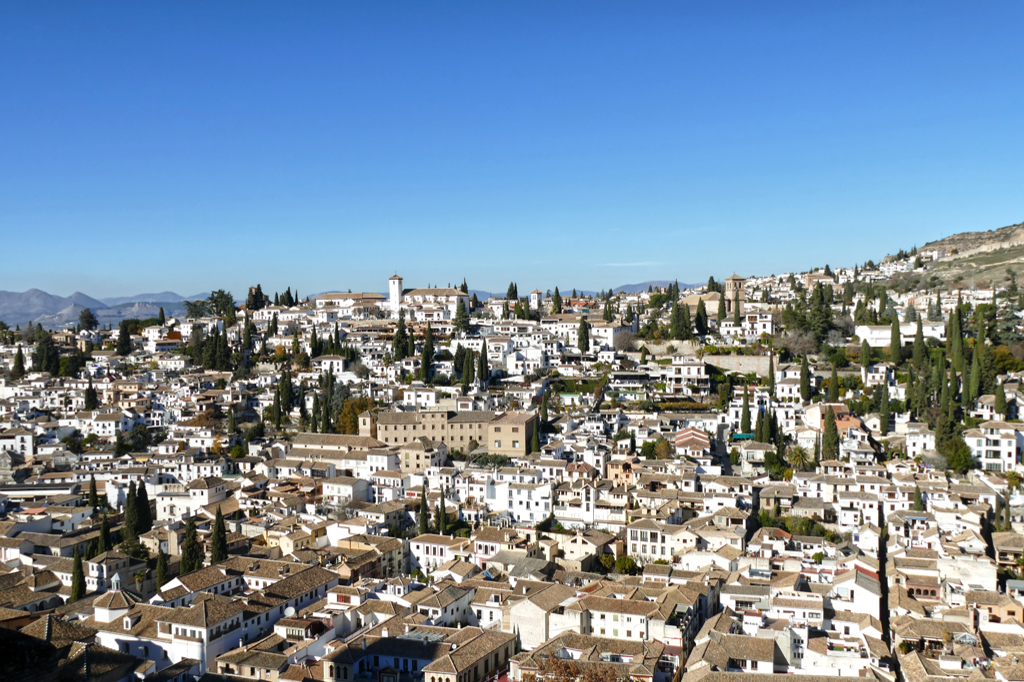
However, to fully appreciate the unique architecture and – literally – outstanding location of the Alhambra, you should make sure to see it from afar as well as from close. The best spots to admire the Alhambra from a distance are the Mirador de San Nicolás on top of the Albaicín and the Sacromonte.
Palacios Nazaries
The Nasrid Palace is the prime attraction at the Alhambra. It is a meticulously elaborated work of ravishing architecture. It consists of stunning archways and windows, carved ceilings, intricate plasterwork, and multicolored ceramic tiles. The complex is a labyrinth of luxurious rooms and precious courtyards.
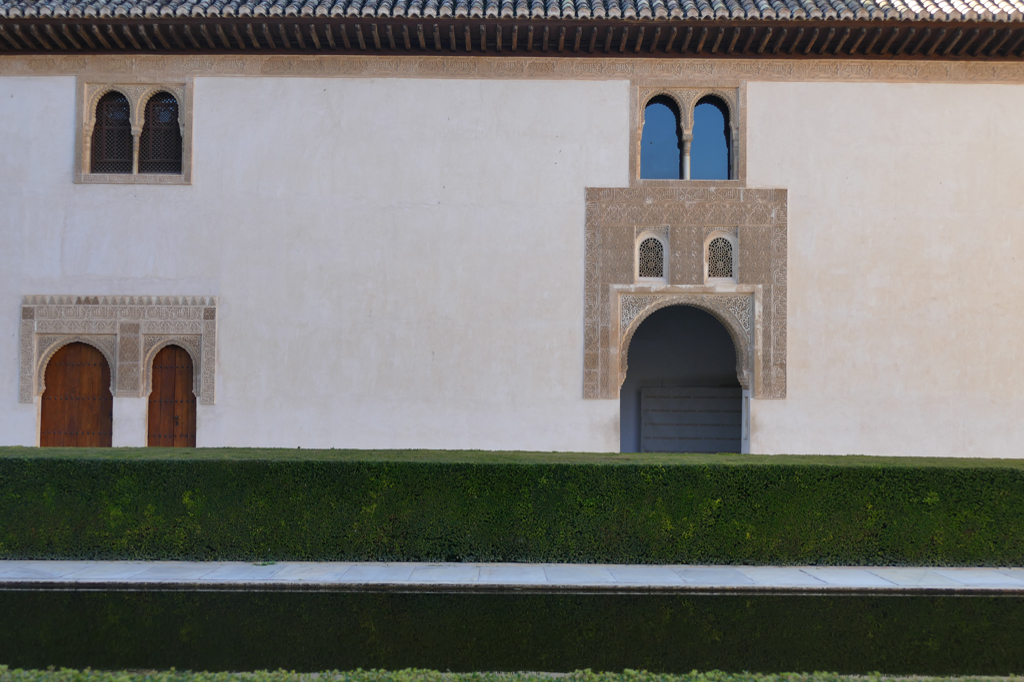
The starting point of the scheduled tours is at the Sala del Mexuar. They were administrative rooms with a beautiful prayer room and a small square courtyard with the golden Façade of Comares. From the Court of the Myrtles, a rectangular courtyard with a long pool of water flanked on each side by a myrtle hedge
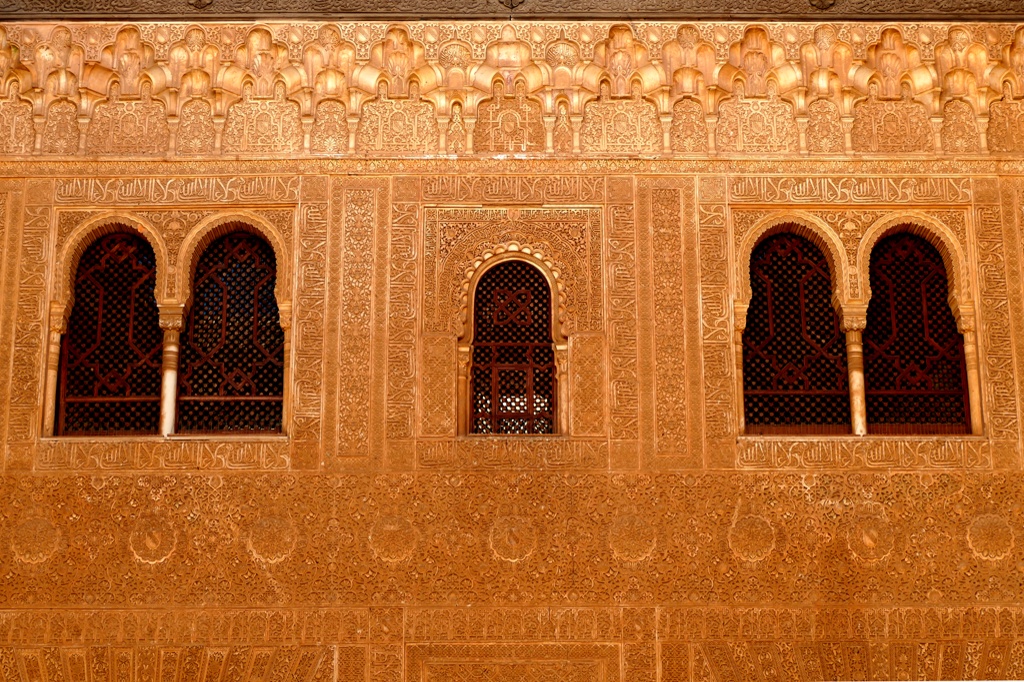
Actually, water is an important asset to the Alhambra. It’s not only a soothing and refreshing element, it is also a mirror. Just take a second look at the picture above how beautifully it reflects the Torre de Comares.
Salón de los Embajadores
As you cross to the other end of the Court of the Myrtles, you enter the so-called Sala de la Barca, a boat room in English. Actually, the name is a simple mistranslation, and the room has nothing to do with seafaring. Amidst its rich plasterwork with the Nasrid coat of arms is the word Baraca which is Arabic for blessing. However, the Castilians understood barca which, of course, translates to boat. Nevertheless, since the artistically carved ceiling has the shape of a reversed boat, you will often hear this interpretation of the name’s origin.

Adjacent is the Chamber of the Ambassadors, the palace’s largest and conceivably most dazzling partition. Once, it was the throne room with floors made from glazed ceramic and ornamented with the coat of arms of the sultans of Granada. Later, they were replaced by clay slabs and tiles.
The ceiling is a masterpiece of carpentry. It is a vault that rises 18 meters high. It is built from cedar wood and has a total of 8,017 inlays of different woods of various colors. In its representation of the firmament, it is truly heavenly.
Patio de los Leones
As you continue from the Chamber of the Ambassadors through a row of small rooms, you’ll reach the small chamber where Washington Irving wrote Tales of the Alhambra. From the open hallway, you have an exceptional view over the adjacent Court of Linda-Raja all the way to the Albaicín.
At the end of the courtyard, you enter a vestibule from where you overlook the entire Patio de los Leones with the eponymous fountain in the center. It is an alabaster bowl carried by twelve water-spouting lions made from marble.
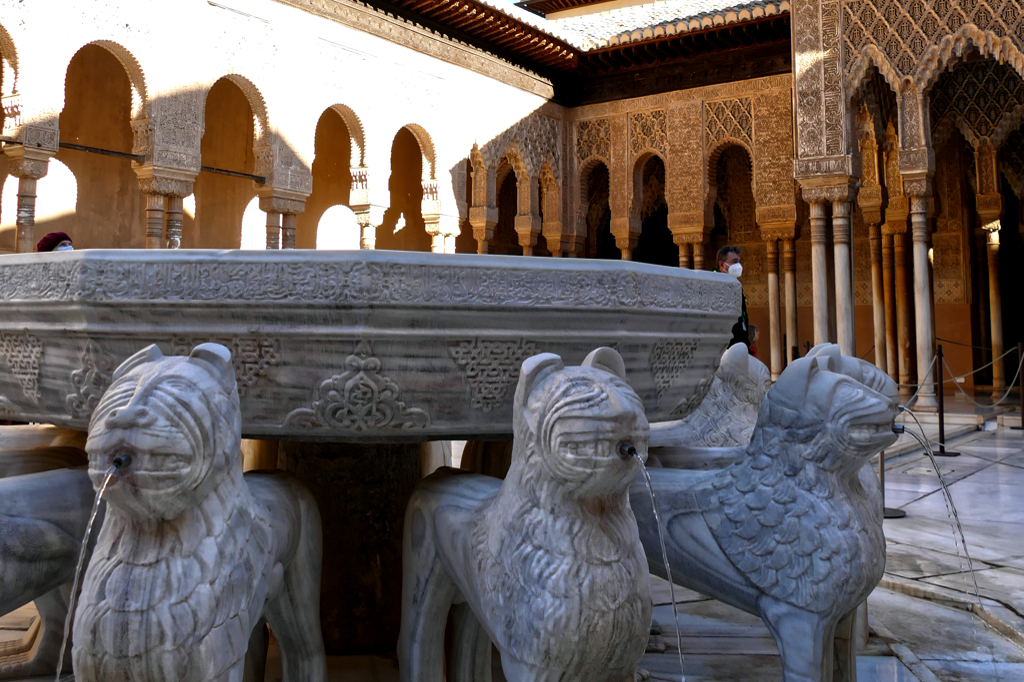
A gallery of not less than 124 fine marble columns surrounds the quadrangle and gives way to manifold beautifully adorned rooms.
Sisters And Kings
One of those rooms is the Sala de los Reyes, the Chamber of Kings, on the eastern side of the courtyard. It is named after the painting on the vault of the central room which depicts the first ten Kings of Granada. Among them is the re-bearded Mohamed ben Nazar, the founder of the Nasrid dynasty. The paintings in the vaults to the left and to the right are paintings portraying knights and ladies. They were created at the end of the 14th century in the times of Pedro I of Castile. At that time, there was a lively artistic dialogue and Pedro I even commissioned Moorish craftsmen from Granada to construct the Real Alcázar in Seville.
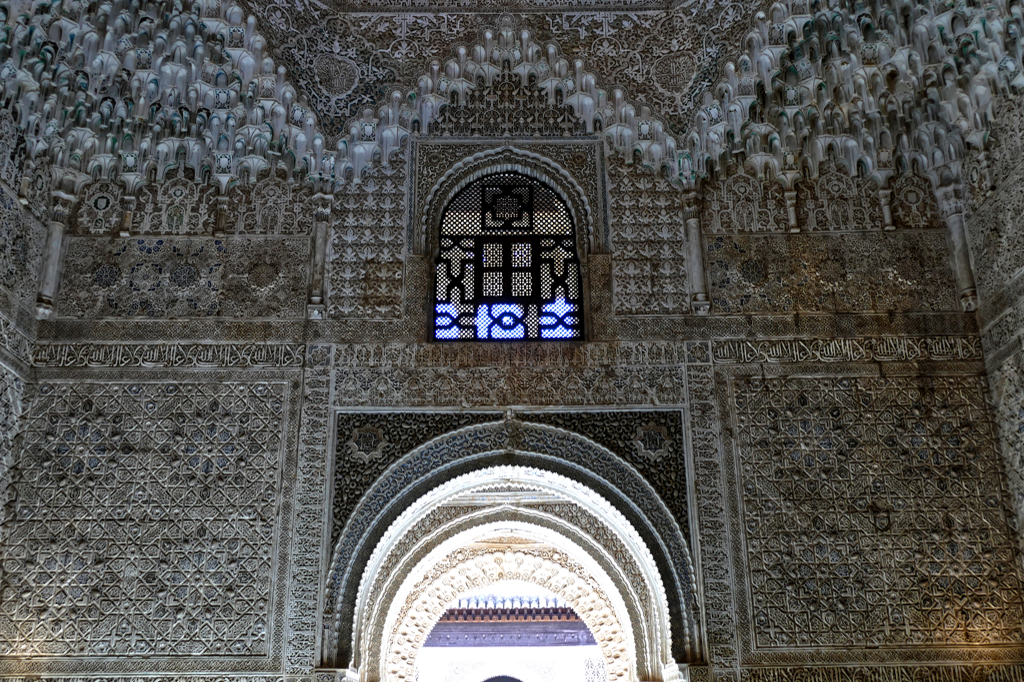
Passing the old bathhouse, you’ll enter the Sala de las Dos Hermanas, the Chamber of the Two Sisters. This room has a truly spectacular domed ceiling with intricate stucco and, like the entire Alhambra, poems written on the walls.
Actually, it was the two white marble slabs on the floor on both sides of the central fountain that inspired the name Two Sisters.
Working your way towards the exit, you’ll reach the Jardines del Partal, a group of gardens with pools and water streamlets. The reflection of the Palacio de Yusuf III in the main pool is one of the Alhambra’s most iconic pictures – and the main picture of this post.
Palace of Charles V
Charles V was the new kid on the Alhambra’s block as he commissioned a Royal Residence right next to the Nasrid Palace following the Reconquista. A square two-level building was built in the Renaissance style in the 16th century. Its most outstanding feature is an impressive circular courtyard surrounded by an arcade of 31 Doric columns on the ground floor and 31 Ionic columns on the upper.
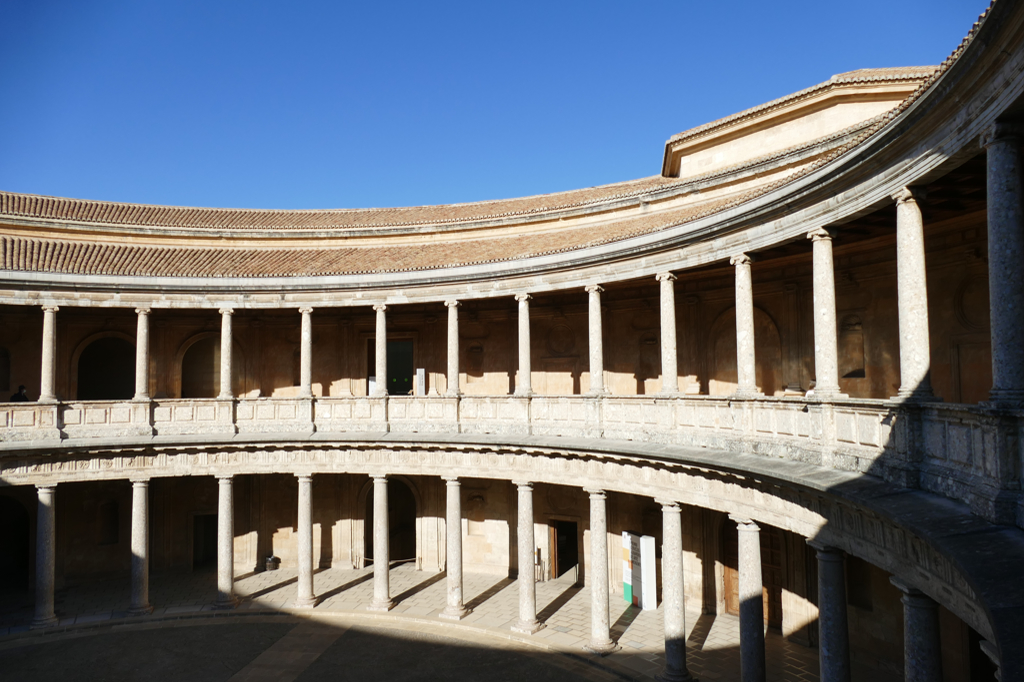
However, he was not such a good neighbor since parts of the Nasrid palace were demolished for the new neighbor’s crib. Also, the construction of the building was a difficult endeavor since the builders were constantly facing financial problems. Therefore, the building remained unfinished until the 20th century. Believe it or not, the palace got its roof only in 1929.
Since 1958, the building has housed the Museo de Bellas Artes de Granada, hence, Granada’s Museum of Fine Arts, as well as the Museum of the Alhambra.
Alcazaba
On the northern tip of the Alhambra are extensive remains of a massive fortress perched atop the hill. From the Torre de la Vela, you have fantastic panoramic views of the entire city of Granada as well as the Sierra Nevada mountains.
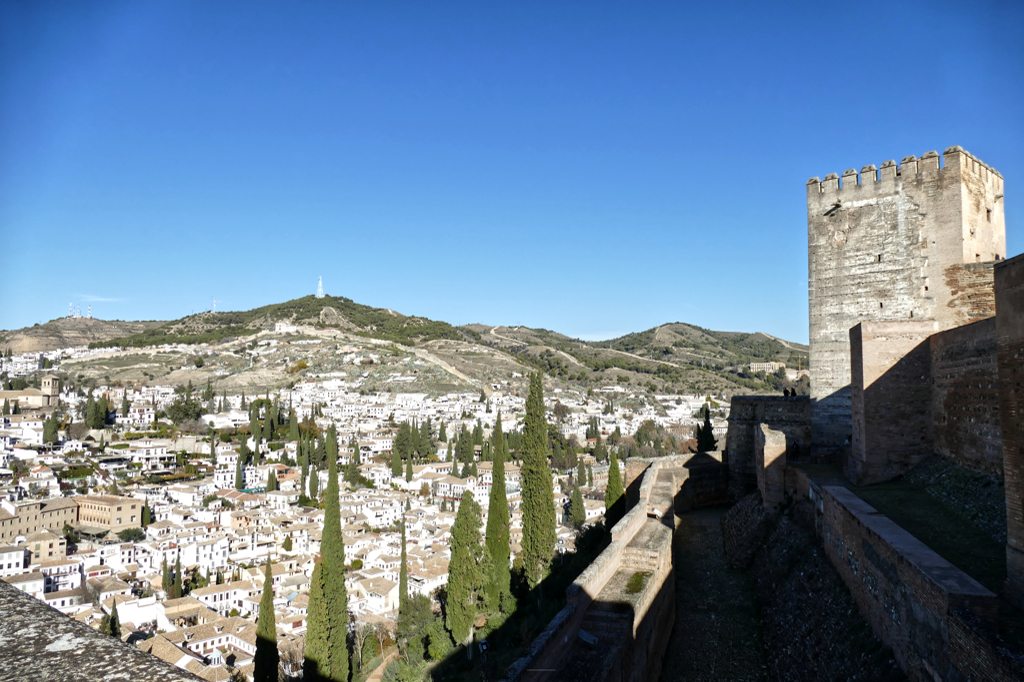
The Alcazaba is the oldest part of the Alhambra since the first historical reference to her existence dates from the 9th century. The current complex was commissioned by Mohammed I and was the Kings’ residence until the palaces were finished. From then on, the Alcazaba was only used as a fortress for military purposes and as the soldiers’ homes and baths. Today only the foundations of these rooms remain.
Generalife
Say It Right
So, tell me the truth: How did you pronounce Generalife? Did the insurance company come to mind and you pronounced it like the synonym of widespread stamina? As a matter of fact, in my head, I’m still doing it, too. But when I open my mouth, I say Heneralefe, since that’s how you pronounce it in Spanish. I would love to let you know where this funny term got its roots, but unfortunately, there are various different theories.
But they all agree on one thing: You do not pronounce it the English way.
A Walk In The Park
The Generalife complex is the finest set of Moorish-style gardens in Andalusia. This park is opposite the Alhambra on a hill and grants some of the best views of the historic complex.
There are beds of colorful flowers, bushes, manicured trees, lovely fountains, and water streamlets arranged in courts.
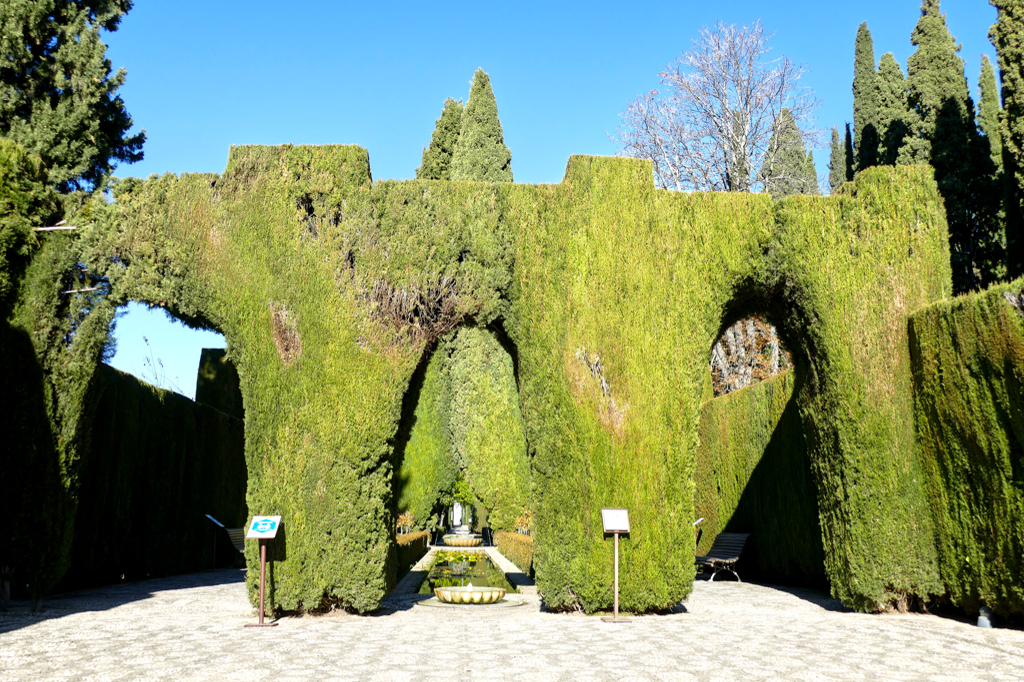
The most iconic ones are the Patio de la Acequia as well as Patio De La Sultana famous for the jets of water sprinkling playfully in the pools.
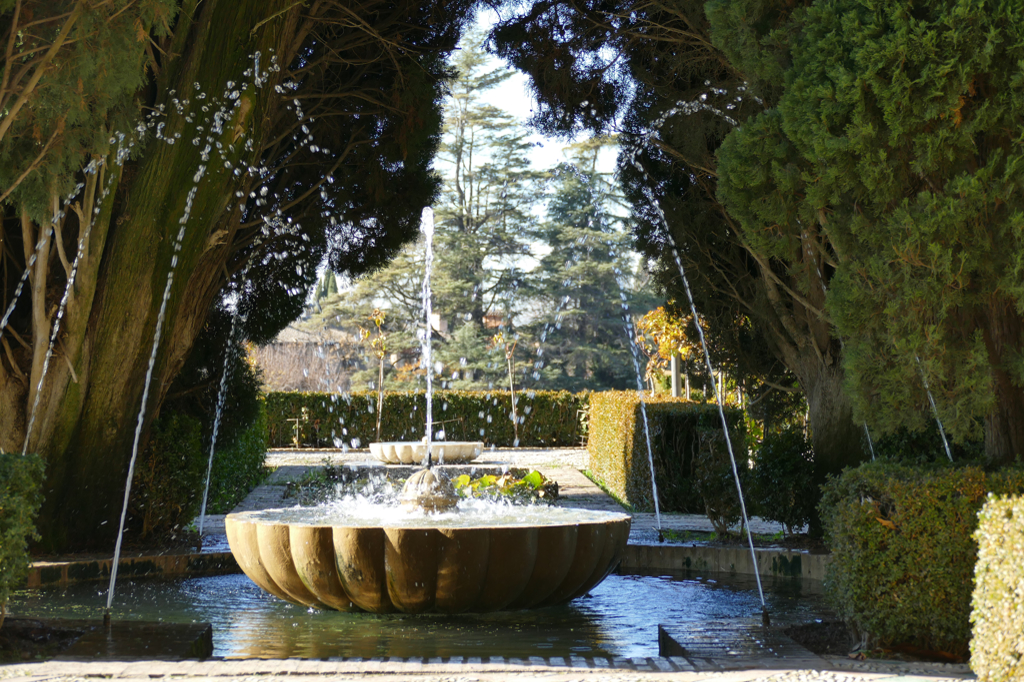
Above the palace are the High Gardens with a lovely long pergola and the famous Water Stairway. True to its name, water is flowing down these beautiful stairs.
Silla del Moro
A short hike uphill from the parking lot east of the Generalife is the Silla del Moro, ruins of an outpost. If you make the effort to walk up that hill, the Silla offers what may be Granada’s most spectacular view.
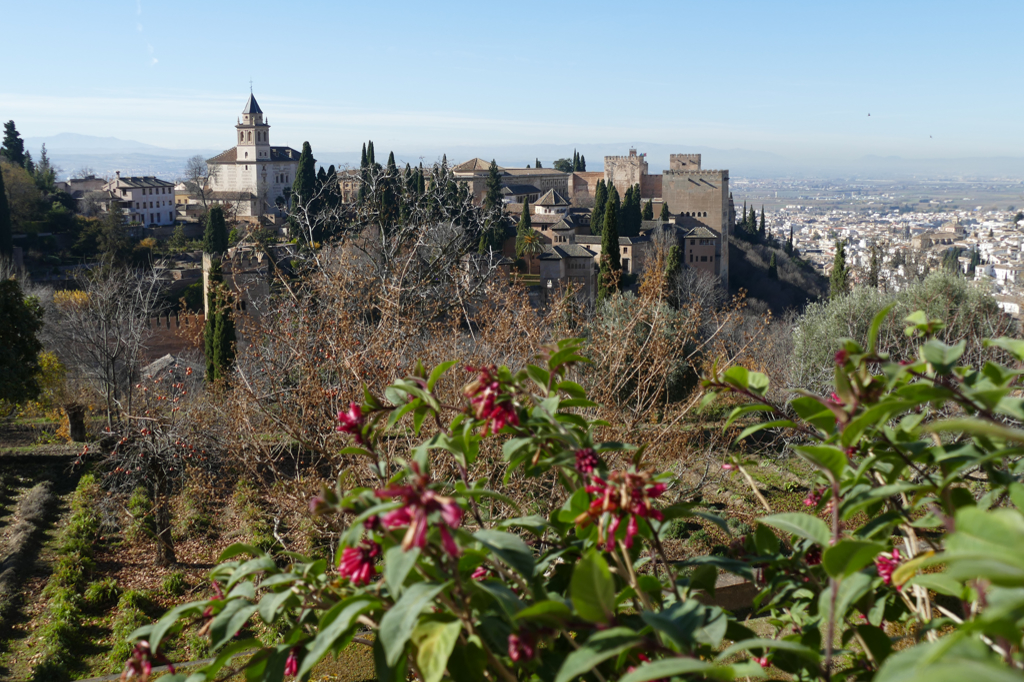
From here, you can actually look down at the Alhambra with a sweeping vista of the city and her surroundings in the backdrop.
Plan Your Visit:
I visited the Alhambra during the pandemic and also in the low season. Therefore, it was not difficult to find a convenient slot for the visit to the Palacios Nazaries. With my Granada Card, I booked a time slot at 1 p. m. This way, I had enough time to visit Generalife before my palace tour and the rest of the complex once I was done. This being said, I’d like to point out that the visit took much longer than I expected since the site is huge. Plan at least half a day for your visit. If you stay longer and Granada and can timewise afford it, an entire day is even better.
It’s highly recommended to buy tickets to the Alhambra long in advance as the number of visitors allowed inside the Palacios Nazaries is limited and tickets tend to sell out.
There are different kinds of visits: firstly, there is the standard day visit that starts between 8 a. m. and 8.30 a. m. and ends at 6 p. m. or 8 p. m., depending on the season. In the evening, there are nocturne visits to the palace and to Generalife. Then, you can visit the premises on your own or on a guided tour. Will say, options are plenty and you can check on their website what works best for you. There you can also book your tickets. The general admission is 14 €uros, however, all the above-mentioned options have different prices.
The Last Resort
In case online tickets are sold out, you still might have another option. For instance, some of the above-mentioned special tickets like for a nightly visit or a guided tour may still be available. Also, the Granada Card includes the entrance to the Alhambra and often there are further time slots available. Don’t worry, you can make sure that there is availability before you hit that order button. Finally, there are two less convenient and far more expensive options you might want to attempt. Either you try to get on a guided tour of Granada that includes a visit to the Alhambra. Or you buy tickets from a reseller which are usually overpriced.
Carmen de los Mártires
Just a couple of minutes’ walk or two bus stops downhill is Carmen de los Mártires, a complex well worth the visit.
When I first read the name, I thought it was a site where some Carmen had to endure terrible martyrdom. Turns out, Carmen is an estate with gardens.
Inside this Carmen, there is a stately building, an artificial lake with a dreamy island, and a set of various gardens.
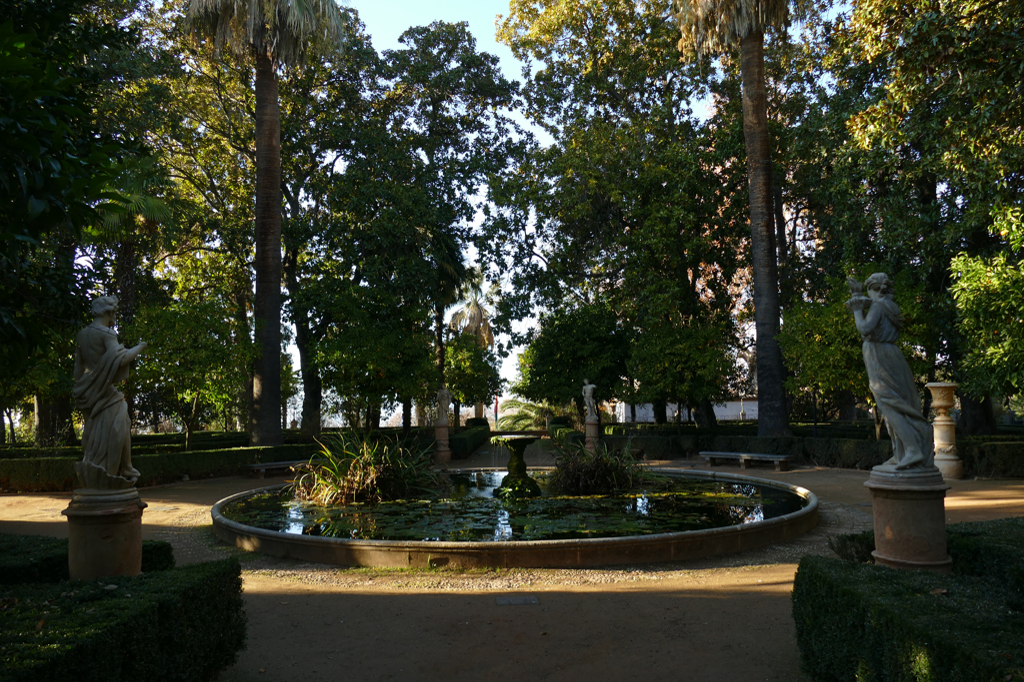
So what’s with the martyrs? Well, after the Reconquista, the place was named Campo de los Christianos Cautivos, hence, Field of the captured Christians, in honor of the Christians captured or murdered there by the Moorish rulers. Then, Isabel la Catolica had the small hermitage Eremita de los Mártire built in this spot.
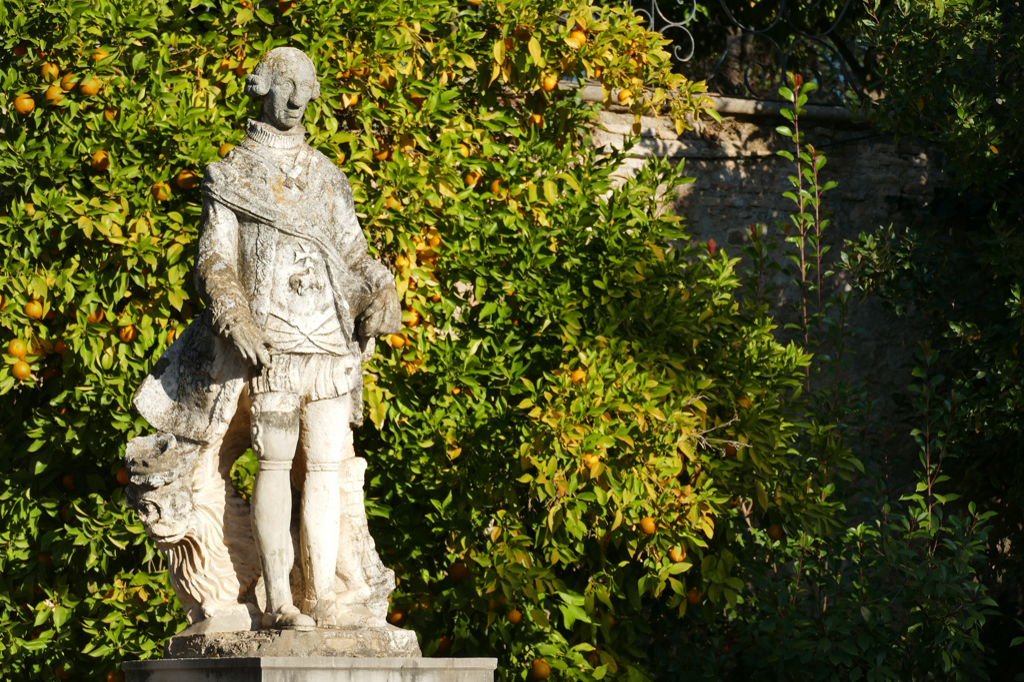
In 1845, General Carlos Manuel Calderón y Molina bought the site and commissioned a residential palace. Various other owners extended and redesigned the estate over the following 100 years.
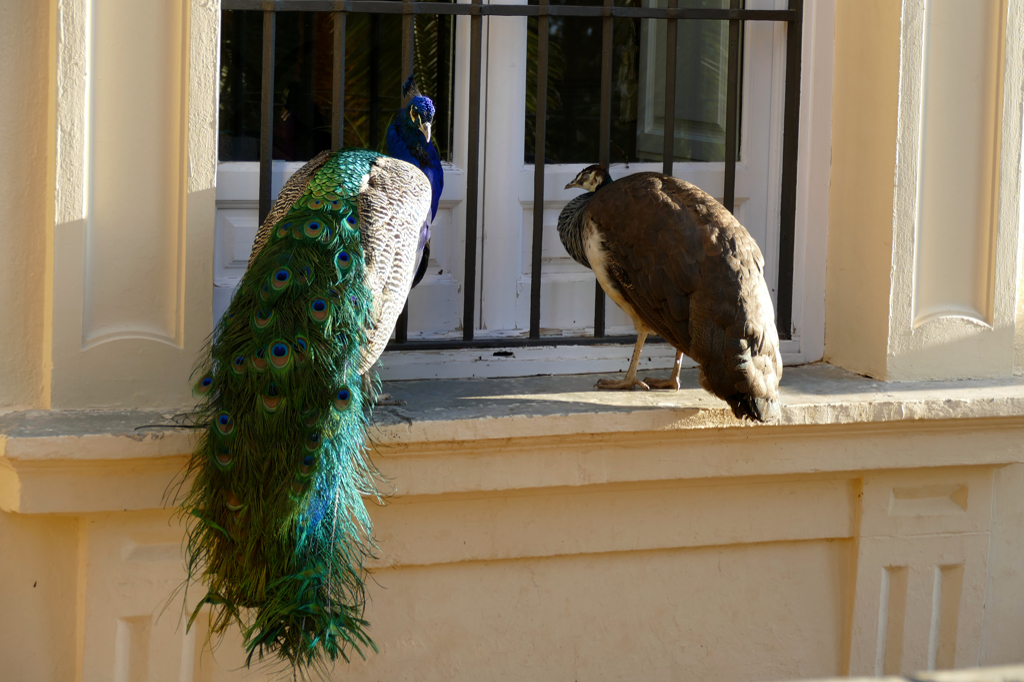
The estate is open to the public every day from 10 a. m. to 6 p. m., however, during the week, there is a lunch break between 2 p. m. and 4 p. m.
Albaicín
Apart from the Alhambra and Generalife the Albaicín has made it to the UNESCO World Heritage Sites. It dates back to the 14th century and was built as a defensive town and Moorish residential area. To this date, it has preserved its pleasant squares, narrow winding streets lined by white-washed buildings, and even a certain Arabic vibe. Located on a quite high hill, it also grants marvelous views, obviously.
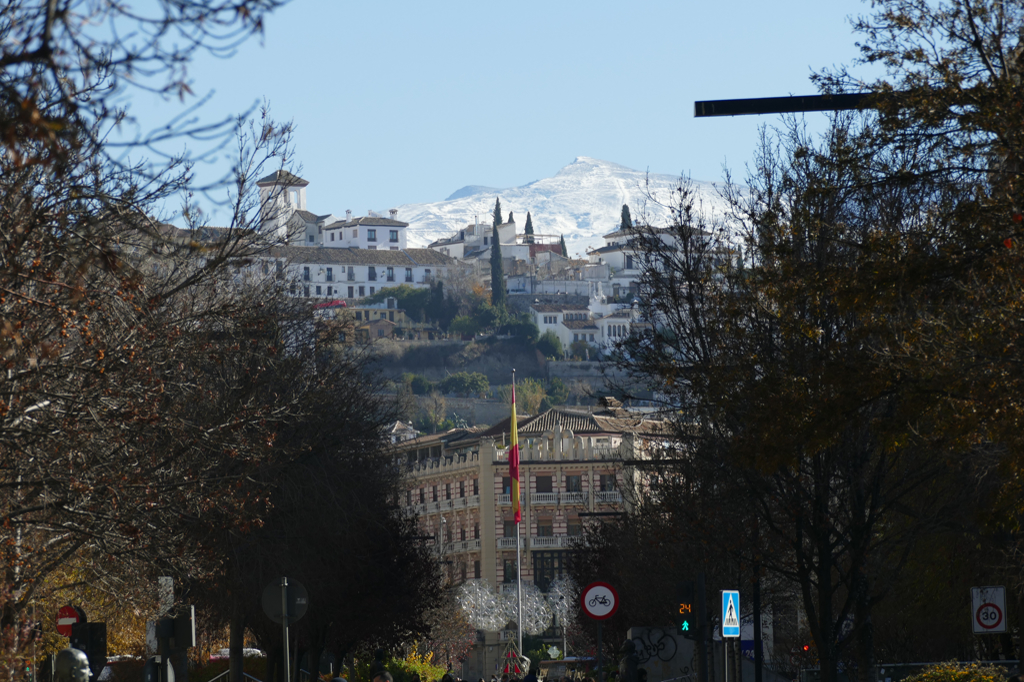
The best way to explore the Albaicín is by taking your time, getting lost in the confusing layout of the alleys and stairs, and just taking in its special atmosphere.
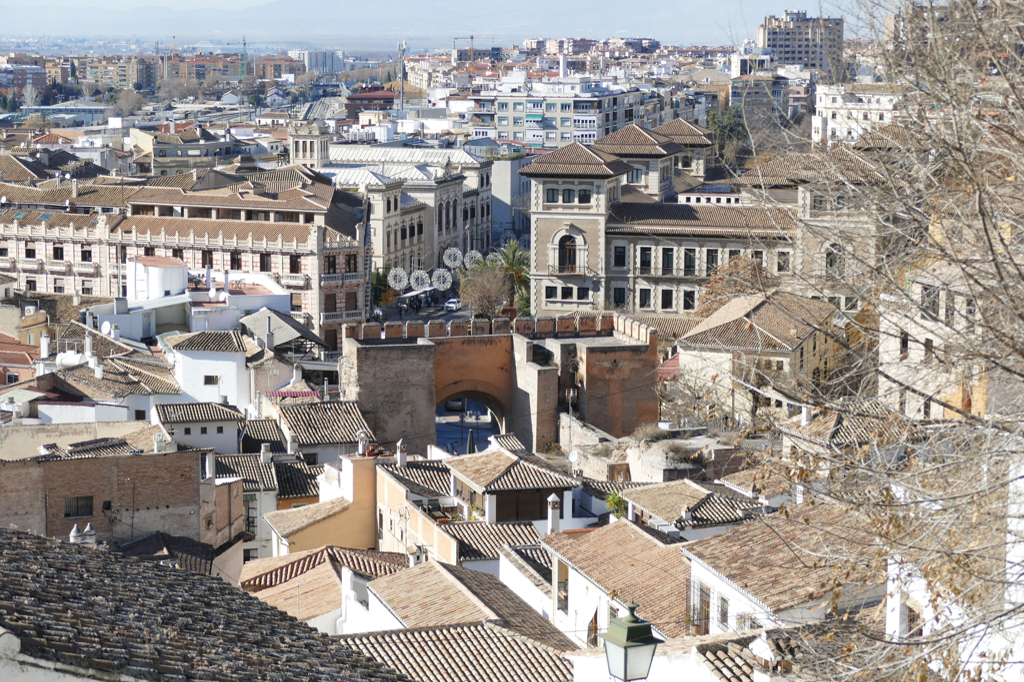
There are various routes to get to the top. For instance, you can walk along the eastern bank of the Rio Darro and turn left at any of the small alleys going uphill. If you are coming from the central area around Calle Gran Vía de Colón, the most scenic way leads up Calle Calderería Nueva near the bus stop Gran Vía 1. Going up this stepped cobblestone street, you’ll pass Arabic eateries, tea shops, bakeries, and specialty stores selling original items from North Africa.
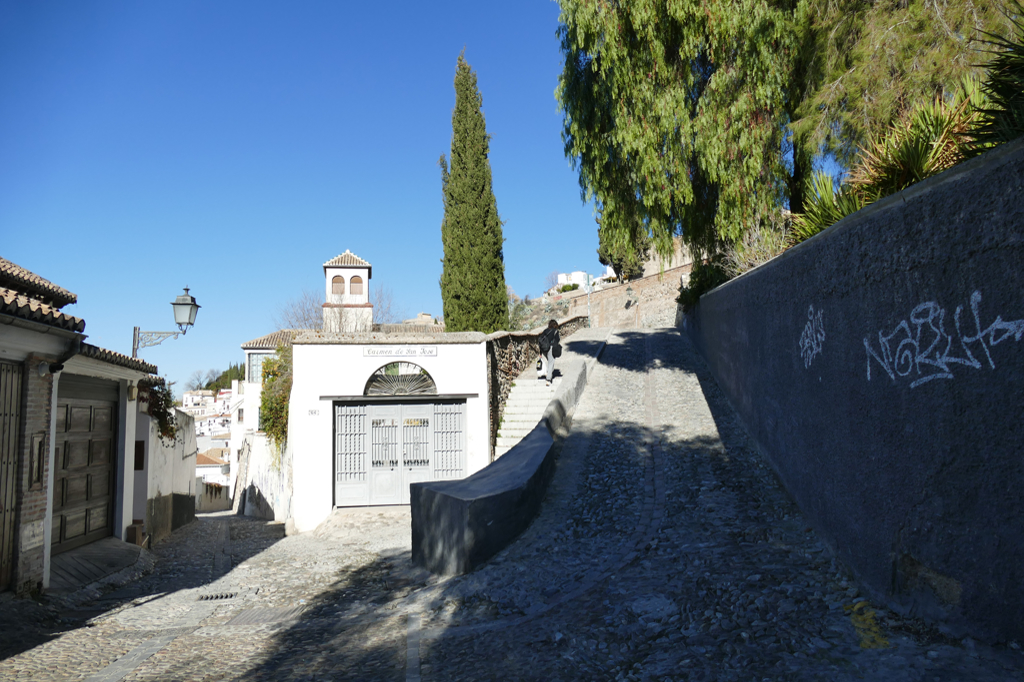
Admittedly, the climb is a climb, and especially during the hot Spanish summer months, nobody can blame you for not climbing up those stairs and alleys. Fortunately, there are two minibusses, number 31 and 32, taking you all the way up from Plaza Nueva. Note that number 32 also has a direct connection to the Alhambra.
Puerta de Elvira
For me, I began my way up high to the Albaicín at the Puerta de Elvira off Plaza del Triunfo. This archway used to be the main entrance to the city of Granada during Moorish rule. Before walking uphill, you might wanna turn right into Calle Elvira, due to its oriental vibe one of the most popular streets in the city.
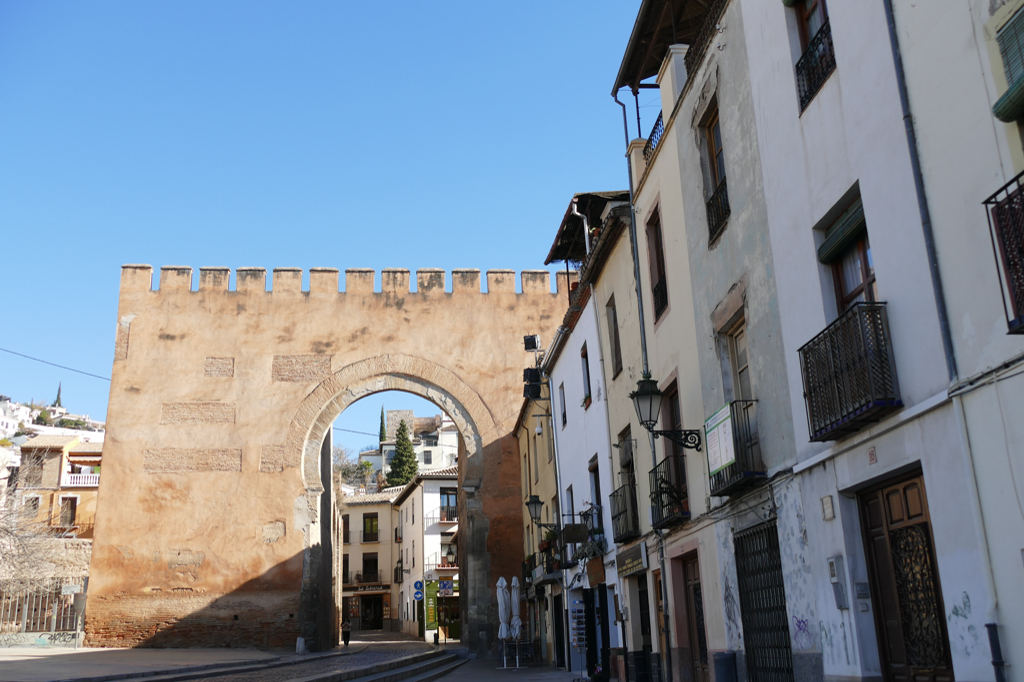
The Zirids commissioned the gate in the 11th century. Eventually, the Nasrid ruler Yusuf I extended into a fortress-like structure. In 1612, the Catholic rulers demolished the fortifications so that today, only the outer arch remains.
Placeta de San Miguel Bajo
Placeta de San Miguel Bajo is one of the most picturesque squares at the Albaicín. It adopted its name for the Iglesia de San Miguel Bajo standing on the eastern side.
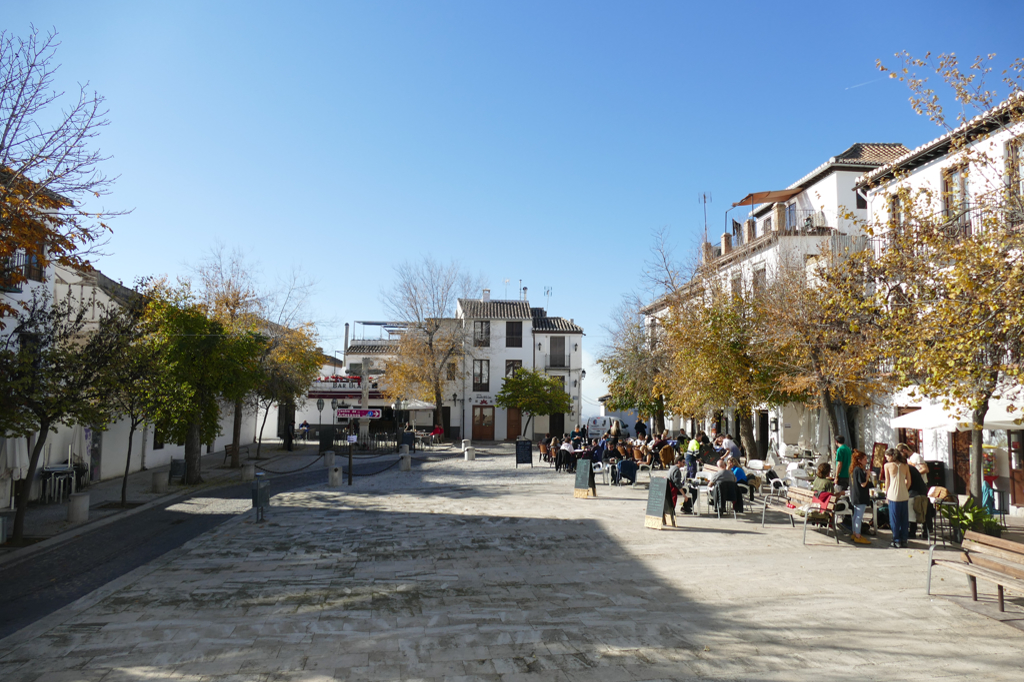
The quite large square – hence, I don’t get why it’s a Placeta, the diminutive of a Plaza – is a popular place for meeting friends over beers and tapas. There is a pleasant mix of people from all different backgrounds so it’s perfect if you want to rub shoulders with locals in a rather untouristy setting.
Through the Callejón del Gallo leading north from the plaza, you’ll get to the Dar al-Horra, a former Nasrid palace from the 15th century.
Cristo de las Azucenas
The Cristo de las Azucenas, also known as the Cristo de las lañas, is looking across the Placeta at the Iglesia de San Miguel Bajo.
After the Reconquista until the 19th century, the city of Granada supposedly lacked religious and patriotic symbols. Therefore crosses were made from various materials and put in prominent spots. Today, more than twenty of these ancient crosses are still standing.
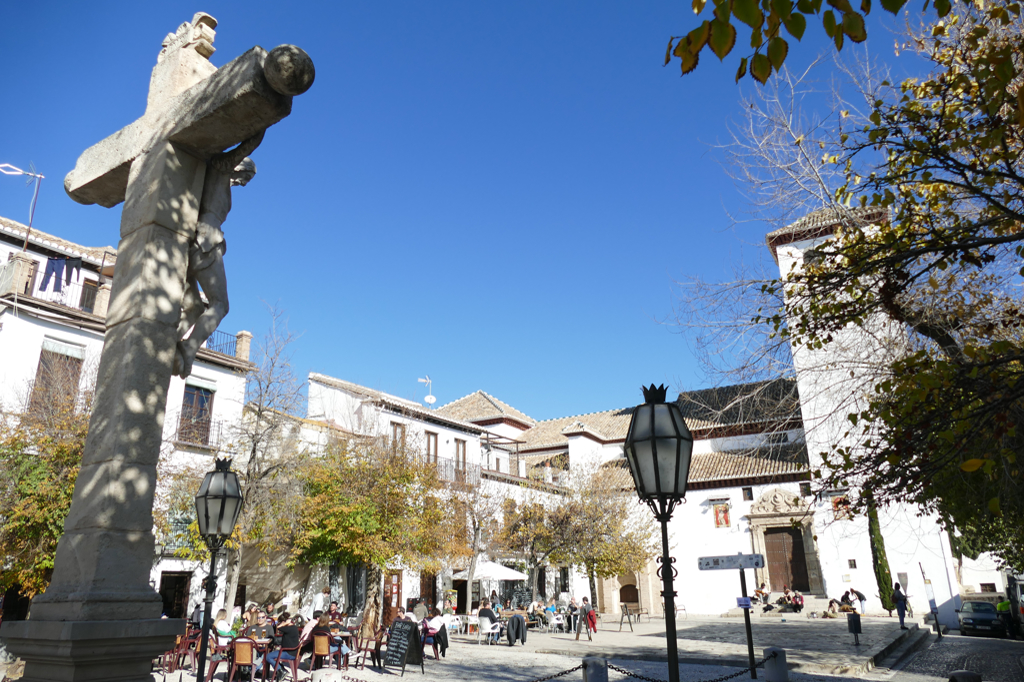
The Cristo de las Azucenas is one of the crosses that remain to this day. Its predecessor actually was made of wood. In the second half of the 17th century, today’s stone cross replaced the wooden one.
Iglesia de San Miguel Bajo
On its eastern side of the square stands the Iglesia de San Miguel Bajo, constructed in 1538. It is a Renaissance church built in the Mudejar style over an old mosque. Of this Muslim house of worship still remains a magnificent cistern with a capacity of approximately 90 cubic meters.
The building shows all the characteristics of the Andalusian Mudejar churches, for instance, its carpentry roof. Inside, the main altarpiece, made by Blas Moreno in 1753, is an exquisite example of the late Baroque.
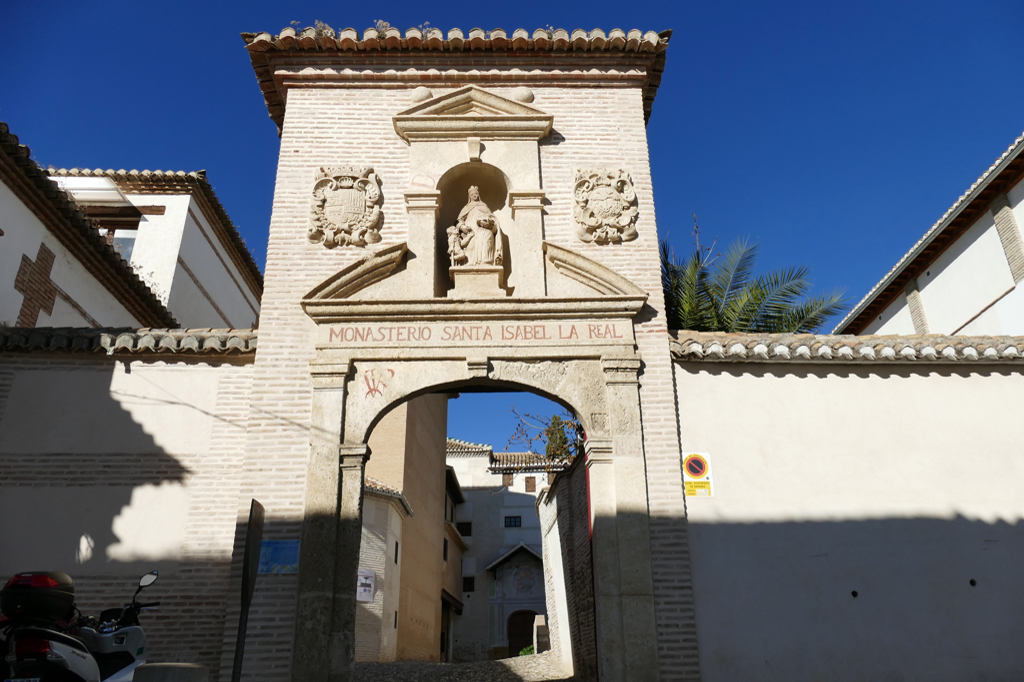
Behind the church is the Royal Convent of Saint Isabel. To no surprise, Catholic Queen Isabella of Castile founded the convent after the Christian conquest of Granada. It stands on the site of the Moorish Palace Dar al-Horra. However, a small part of the Palace was exempt from demolition and is found on the northern end of the convent.
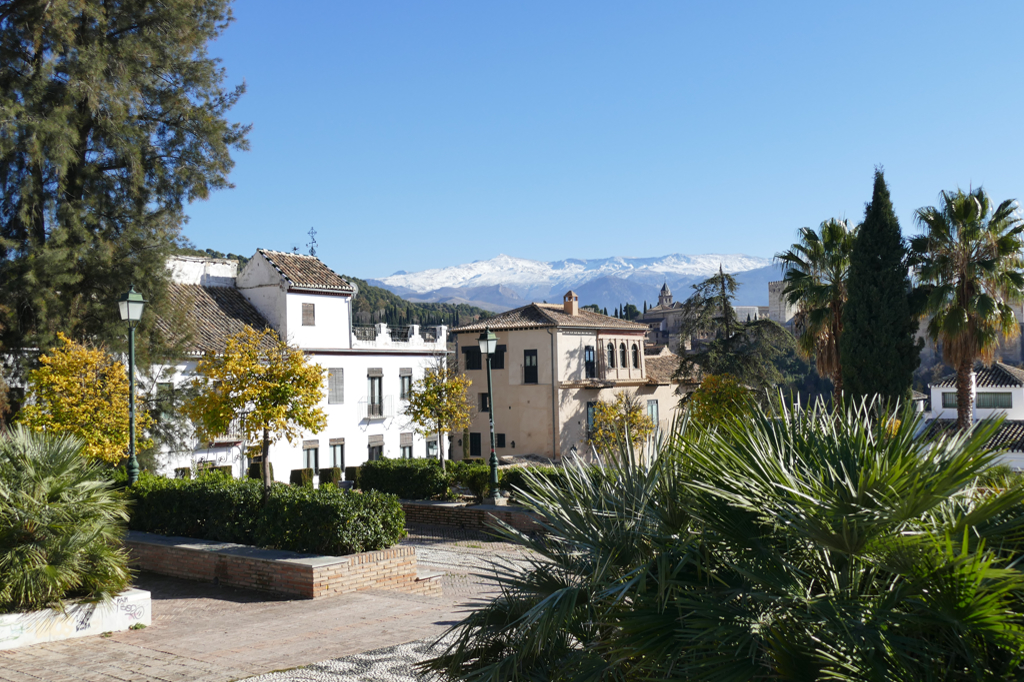
To the convent’s east is the Placeta Cristo de las Azucenas with the Mirador de Santa Isabel la Real. I’m afraid to repeat myself when I extoll once again the mesmerizing view.
Plaza de San Nicolas
Talking ’bout views – we are getting to the best one, the view of all views, so to speak. Yes, the San Nicolas Viewpoint on the eponymous square is definitely the most popular place at the Albaicín, especially for visitors. From this spot, you’ll have a spectacular view of the Alhambra and the snow-covered mountain range in the backdrop.
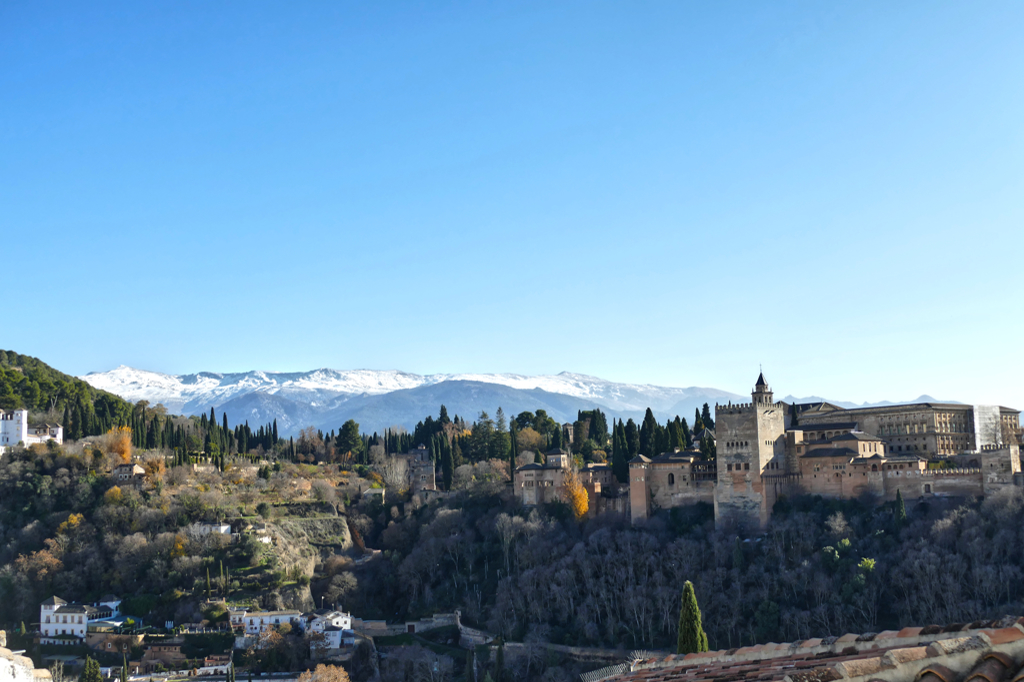
Yet, the square is the ideal spot for a relaxing break not only for the views. Just sit down on the stairs behind the low fence next to artisans and musicians and let the vistas sink in.
Once you’re ready to continue your tour, you might want to visit the Mezquita Mayor de Granada just east of the Plaza San Nicolas.
Following the Reconquista, the Catholic rulers banned Islam and persecuted its faithful.
However, in recent years, Islam is spreading in Spain. Hence, a new beautiful mosque was built in 2003.
The mosque is open to visitors. While you need to make an appointment to see the main prayer rooms, you are free to enjoy the garden and the outside architecture of this rather austere building.
Puerta Nueva or Puerta de las Pesas
Actually, locals use the Plaza Larga as the main access to the Albaicín. There are shops, restaurants, and a local market on Saturday mornings. On the square’s west side, tucked around a corner, is the Puerta Nueva, a narrow passageway to the Placeta de las Minas inside the Albaicín.
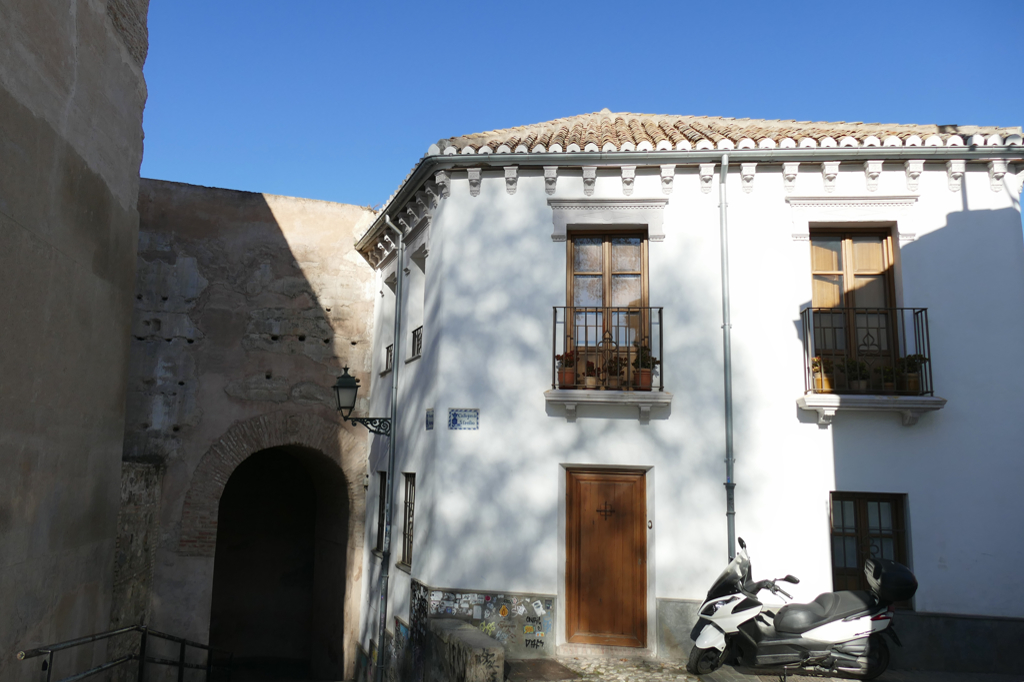
The gates alternative name Puerta de las Pesas, Door of Weights, refers to fraudulent weights confiscated from the butchers next to the Plaza Larga.
To this date, you can see weights hanging on top of the horseshoe-shaped gate similar to those seized in the olden days.
Carrera del Darro
The Carrera del Darro stretches from east to west below the Albaicín. It is a narrow street on the banks of the Rio Darro. Although you might need to squeeze to one side to let a cab or minibus pass, it is undoubtedly one of the most scenic walks in the city. Many of the beautifully preserved houses house restaurants where you can enjoy serenity and good food at the same time.
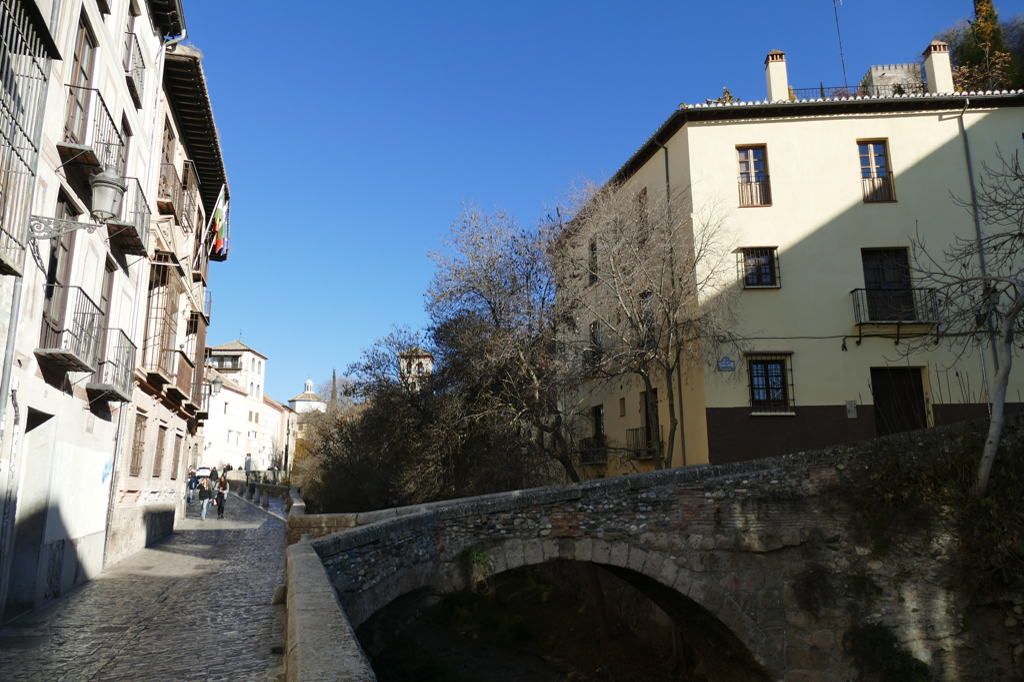
It really took me a moment to find the entrance to the Bañuelo, the well-preserved remnants of an Arabic bathhouse. It is hidden just steps behind the picturesque Puente Espinosa. Once it was a popular socializing spot among Granada’s Muslim population. Obviously, after the Reconquista, most of the bathhouses in the city were destroyed. The fact that there is a private home above the Bañuelo saved this little hidden gem from demolition.
At the end of Carrera del Darro is the Paseo de los Tristes. Once it was Granada’s busiest gathering spot in Granada, probably also due to its location between the Alhambra and the Albaicín. Therefore, to this date, it is one of the best places to dine with a view.
The Bañuelo is open every day from 10 a. m. to 5 p. m. The entrance fee is 5 €uros, however, this is a combi ticket that also grants access to the so-called Monumentos Andalusíes which are the Corral del Carbón, Casa Horno de Oro, and the Dar al-Horra. All these landmarks are also included in the extended version of the Granada Card.
Sacromonte
Locals often consider the Albaicín a world apart from the rest of the city. But even this former Arabic quarter can’t compete when it comes to the seclusion and uniqueness of Sacromonte. It is a Roma district east of the Albaicín. The community is famous for its cave dwellings. The district is also a popular flamenco place, mainly among tourists. Finally, to no surprise, Sacromonte is favored for the views of the city and the Alhambra. However, if you want to take pictures, you should rather get there in the morning so that you have the sun behind you.
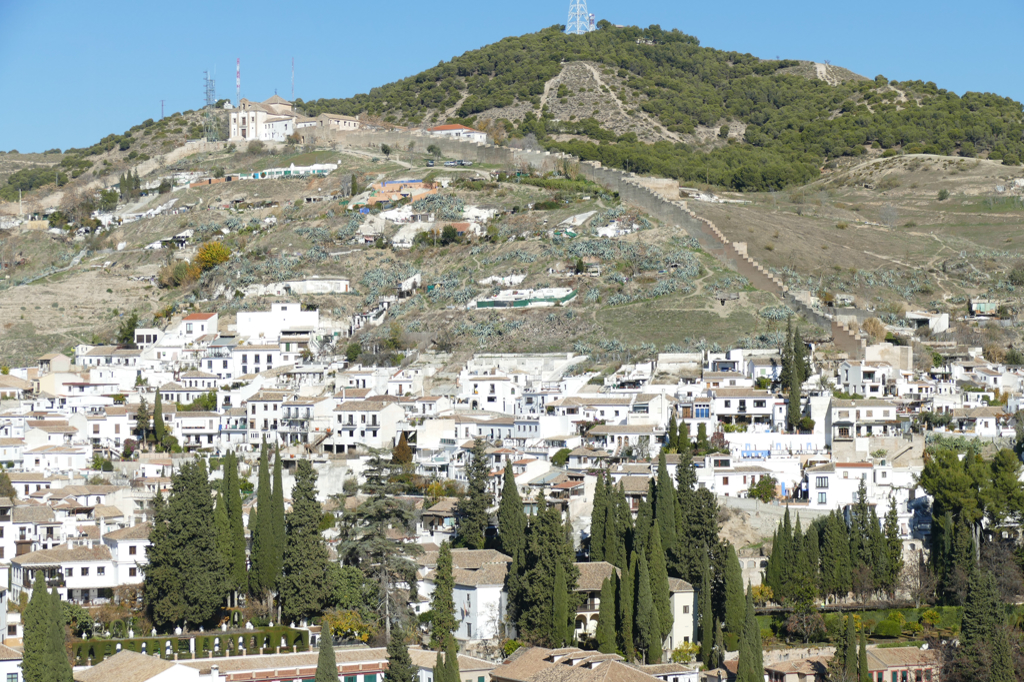
Obviously, you can walk uphill the Sacromonte, however, it’s quite an exercise – especially in summer. But Granada wouldn’t be Granada if there weren’t a convenient connection by minibusses number 31 and 32. They are leaving from the Plaza Nuova.
Abadía del Sacromonte
In the 16th century, the relics of three saints were found in the Santas Cuevas catacombs.
At the beginning of the 17th century, an Abbey was built. Immediately, the complex was of great cultural and religious significance.
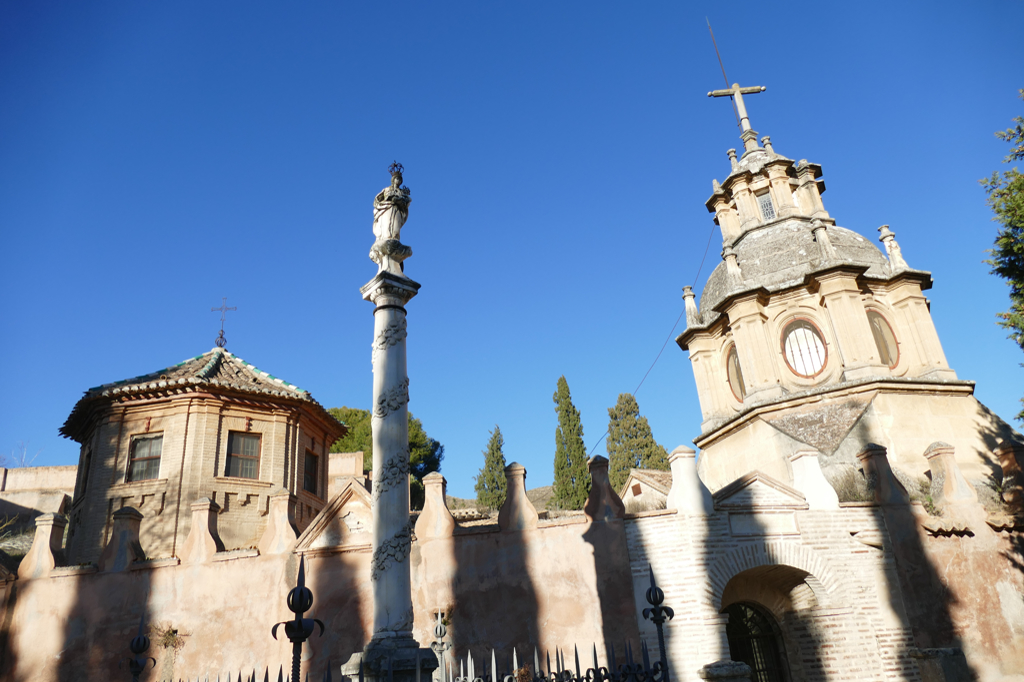
As a matter of fact, it was the appeal of this godly place that attracted many pilgrims. This finally led to the settlement of what is now the Sacromonte district.
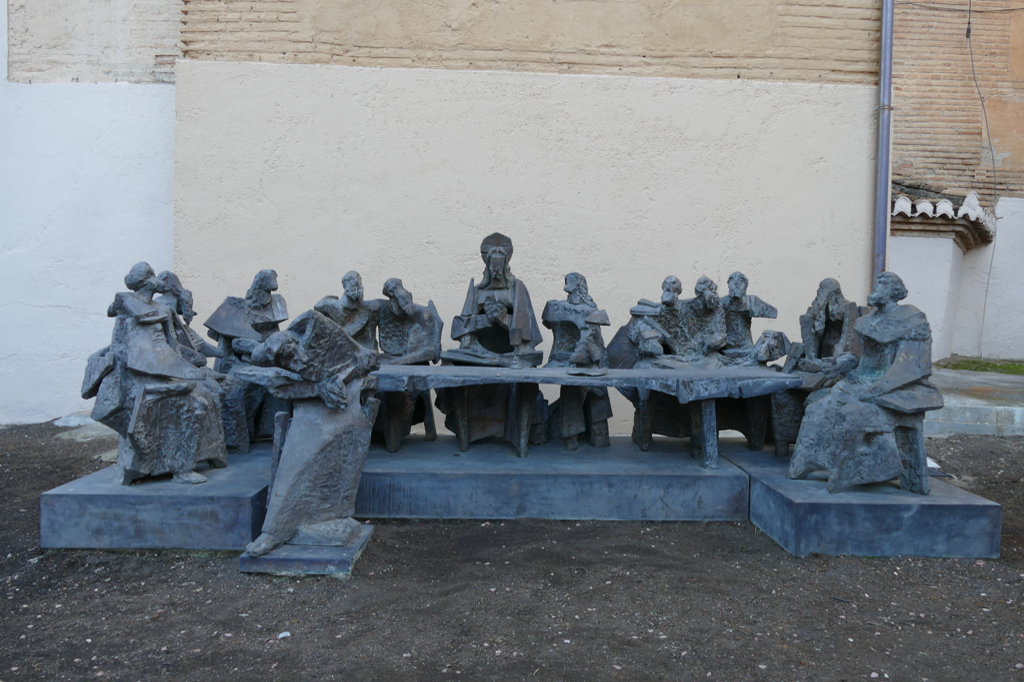
Today, the complex consists of the Santas Cuevas, the Abadía building, the Colegio Viejo de San Dioniosio, and the Colegio Nuevo.
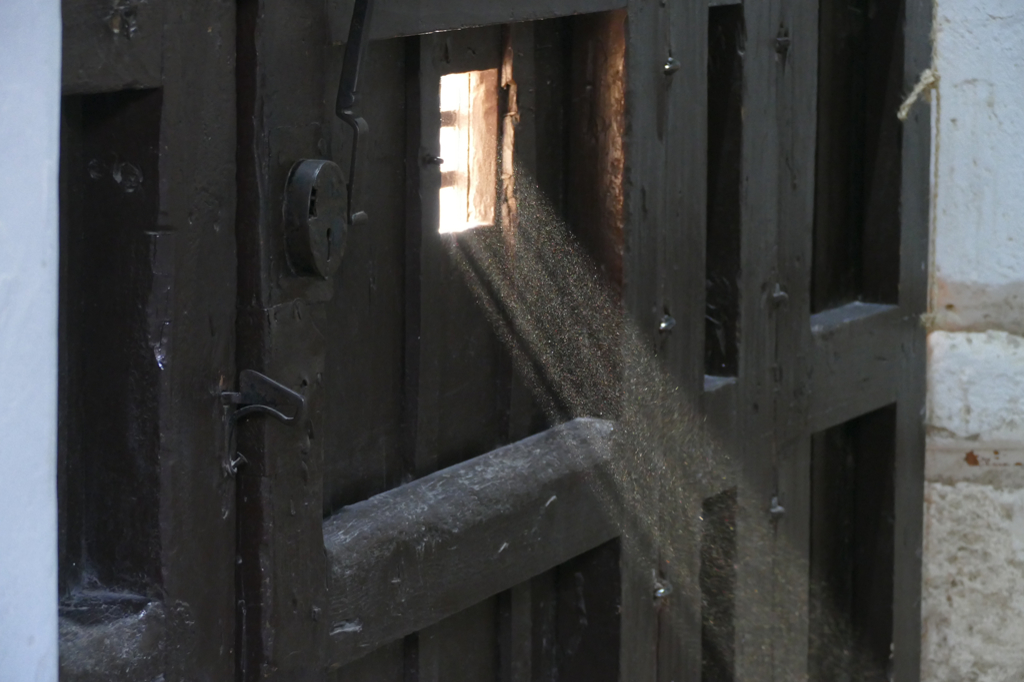
The museum was opened in one of the wings only in 2010. It houses monographs, artworks by local artists from the 16th and 17th centuries, as well as some works by internationally renowned masters such as Francisco Goya. Walking through dark narrow passages, you’ll get to the Santas Cuevas.
Plan Your Visit:
The Abadía del Sacromonte can be visited every day between 10.30 a. m. and 7.30 p. m. with a lunch break between 2 p. m. and 4 p. m. Especially during high season, it is recommended to make an online reservation through their website well ahead. The general entrance fee is 5 €uros, however, it’s included in the Granada Card. However, you should book your – free – tickets ahead.
Museo Cuevas Sacromonte
In the Abbey’s vicinity, you will also find the Cuevas de Sacromonte. A large group of Roma settled here in cave dwellings in the 15th century.
As a matter of fact, it was the Roma who invented the flamenco and they are still many flamenco shows taking place in the cave dwellings. These shows seem a bit touristy, however, a visit to the grottos and the cave museum might be worth your visit since this sort of housing is quite unique, indeed. In the museum’s eleven cave dwellings, you get information about the history and traditions of the inhabitants of Sacromonte.
Given the socio-cultural problems the Roma population is facing basically everywhere in Europe, I have strongly mixed feelings about this sort of tourist attraction, to say the least.
Plan Your Visit:
The museum can be visited every day between 10 a. m. and 6 p. m. from October till March. From April to September, it’s open till 8 p. m. The general entrance fee is 5 €uros.
Aynadamar
Somehow, many of Granada’s landmarks did not meet my expectations – and that’s not necessarily a bad thing. While some of the hyped attractions left me rather oblivious, others unexpectedly simply blew me away. And the monastery La Cartuja on the Aynadamar falls definitely in the latter category.
The Aynadamar is an elevation north of the city center. Here you’ll find some of the newer neighborhoods. However, since also the huge campus of the Universidad de Granada spreads over the Aynadamar hill, this institution definitely has a strong impact on the vicinity.
Monasterio de Nuestra Señora de la Asunción La Cartuja
The cloister Nuestra Señora de la Asunción was founded in 1506. Nevertheless, the construction started only ten years later and took a little something of 300 years. Today, only parts of the original structures exist as French troops destroyed major parts of the monastery in 1824. Today, the monastery no longer belongs to the Carthusian Order, but it is governed by the Archbishop of Granada.
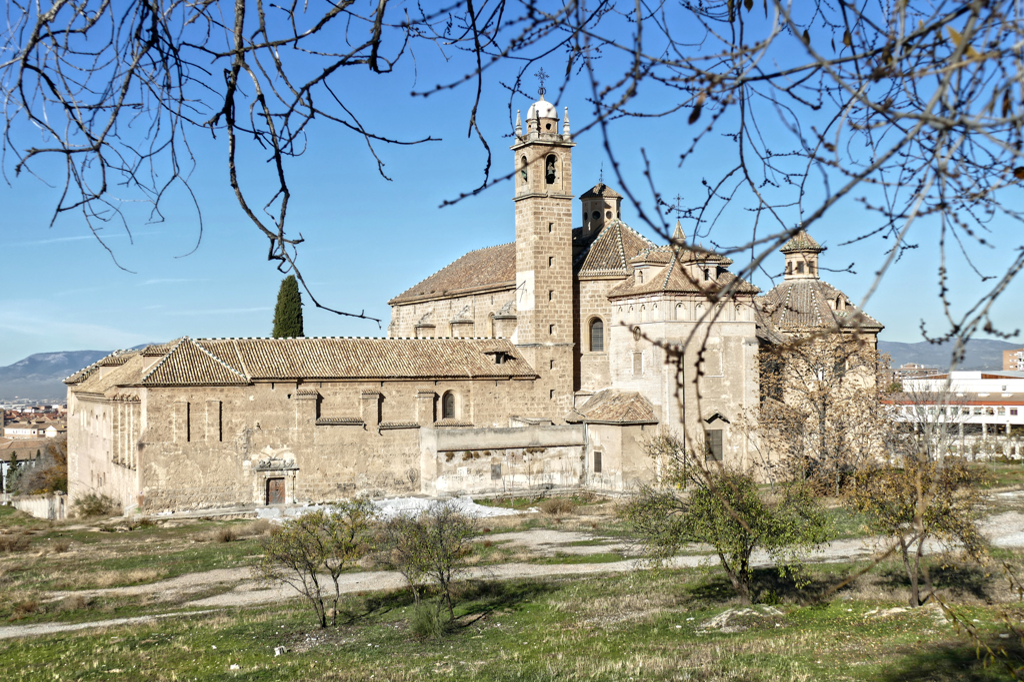
While the building’s exterior is not really special, the interior is flamboyantly decorated.
The Refectory
This first room was the place where the monks prayed before lunch while the adjacent room was originally used as a church. Today, it is the oldest part of the complex where you can admire paintings by Vicente Carducho.
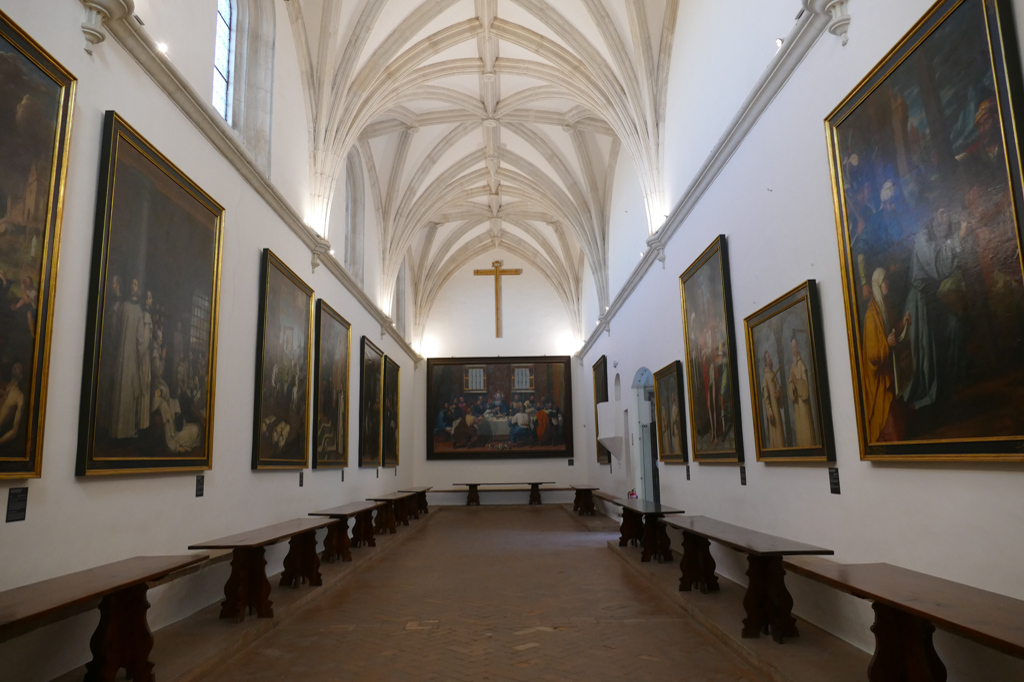
The refectory is a simple room with a ribbed vault. Yet, the walls are decorated with precious paintings by Fray Juan Sánchez Cotán.
The Church
The church is undoubtedly one of the greatest treasures of this monastery. Its construction was completed in 1662.

The original design foresaw four towers at the corners of the nave, but finally, only one was built. Interiorly it has a single nave, with a groined roof lavishly decorated.
The Sanctuary
The architecture, the decorations, and the paintings combined form an unparalleled masterpiece. To create this chef-d’oeuvre, Hurtado Izquierdo surrounded himself only with the most talented stonemasons, painters, and sculptors of his time.
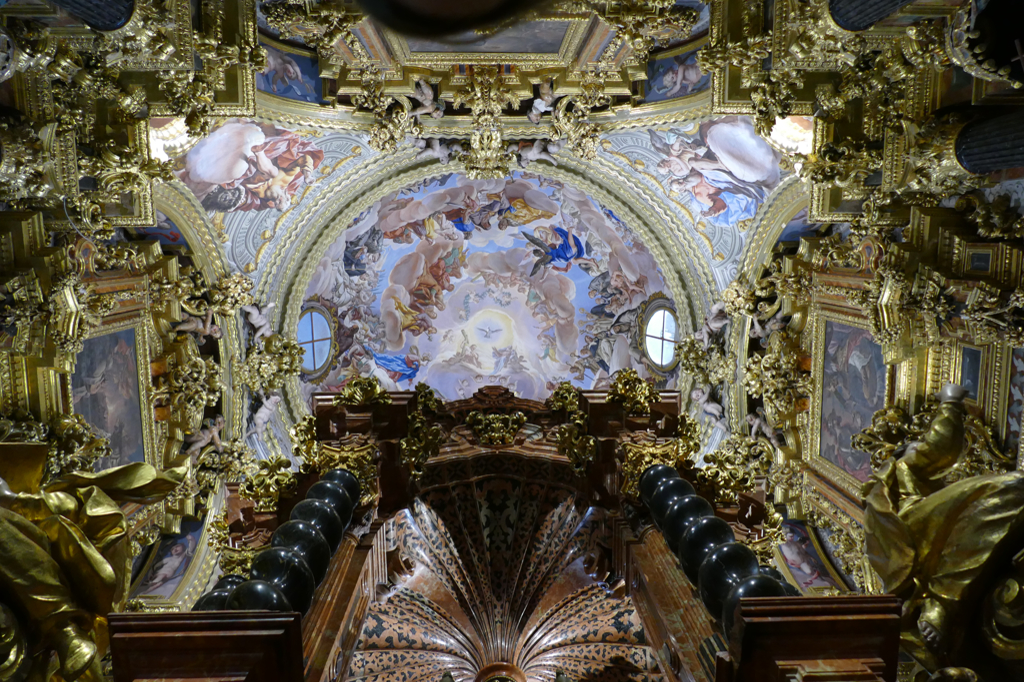
The luxurious materials such as marble of different colors, gold, sculptures, and paintings reflect great splendor and at the same time a deeply religious significance.
Of major importance is the marble tabernacle in the center of this space. Like a stone monstrance, it leads your glance to the beautifully painted ceiling.
The Vestry
And as you think that after the sanctuary, it cannot get any more beautiful, you enter the vestry and immediately stand corrected. Its construction began in 1732, probably also designed by Hurtado Izquierdo.
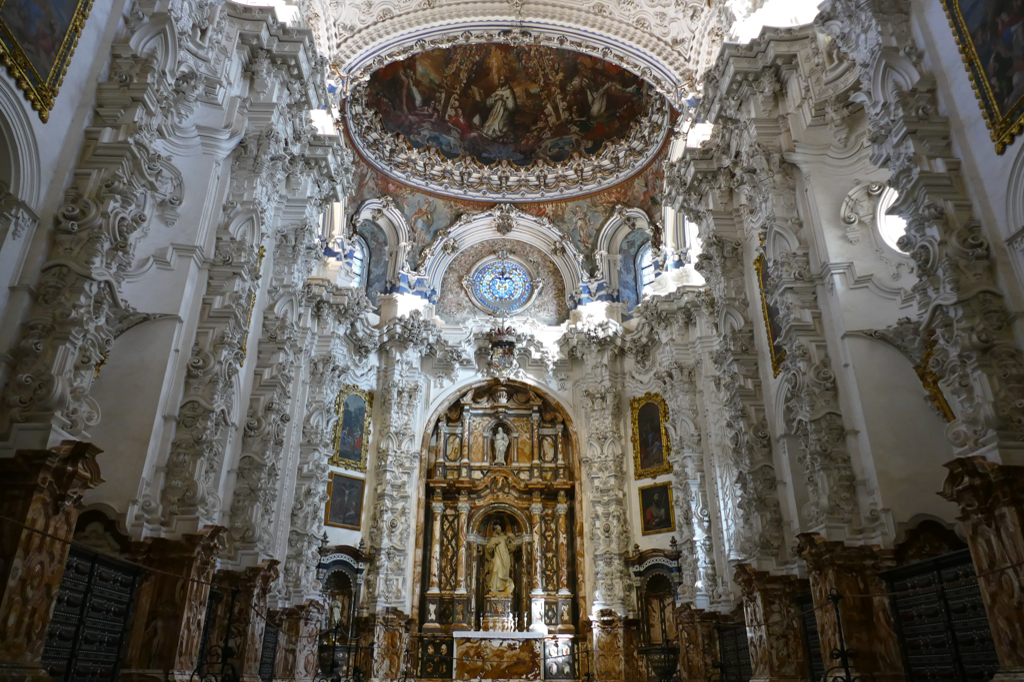
All the walls are gaplessly covered by beautifully carved stucco. The central cupola amidst the blindingly white walls has a simply mesmerizing effect. This room is a masterfully executed creation that will leave every visitor speechless.
Plan Your Visit:
The Cartuja can be visited every day from 10 a. m. to 5.30 p. m., however, on Saturdays, there is a lunch break from 12.30 p. m. to 3 p. m The general entrance fee is 5 €uros, yet, the visit is included in the Granada Card.
Best Flamenco Show In Town
Yes, I’m nothing but a simple tourist and therefore, I enjoy doing touristy things occasionally. Visiting a fiery flamenco performance is one of the most popular touristy things to do in Spain, obviously. Nevertheless, I was keen to get at least some authenticity and was therefore very happy to have stumbled upon Casa Ana.
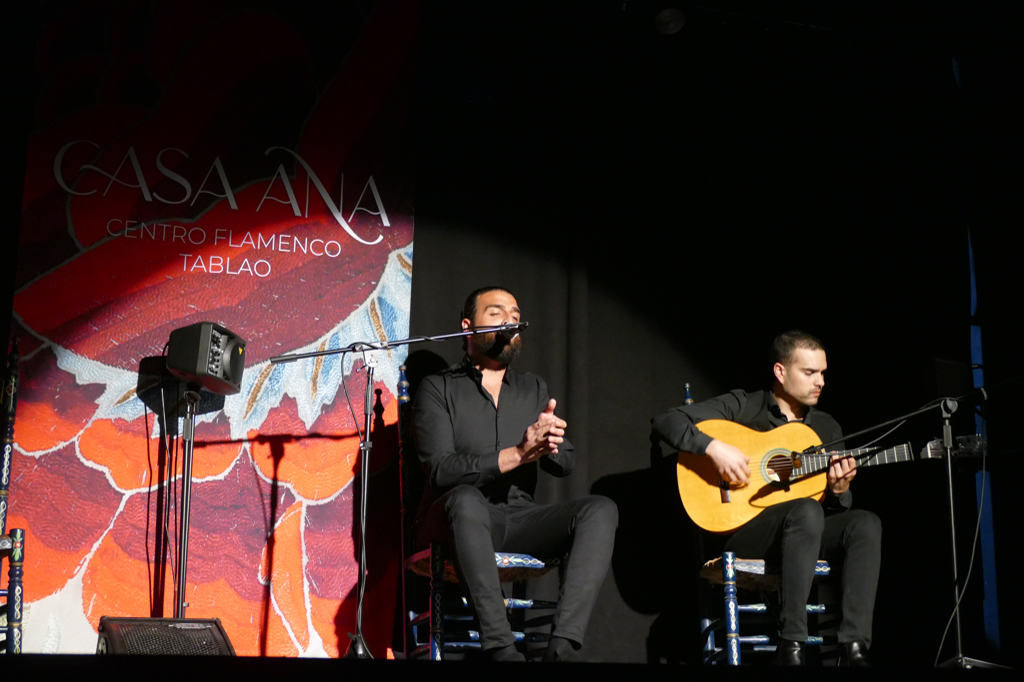
Casa Ana lies a bit hidden in a side street behind the Palacio de la Real Chancillería. It is not some tourist trap, on the contrary, a space where the art of flamenco is cherished; and taught.

Under the guidance of director José Núñez, a dancer from Cádiz with more than twenty years of experience they master the art of combining a theatric performance with traditional tablao.
But José and his talented and passionate co-dancers don’t only perform nightly flamenco shows for an enthusiastic audience. The master also shares his art with disciples by giving classes at the affiliated flamenco school.
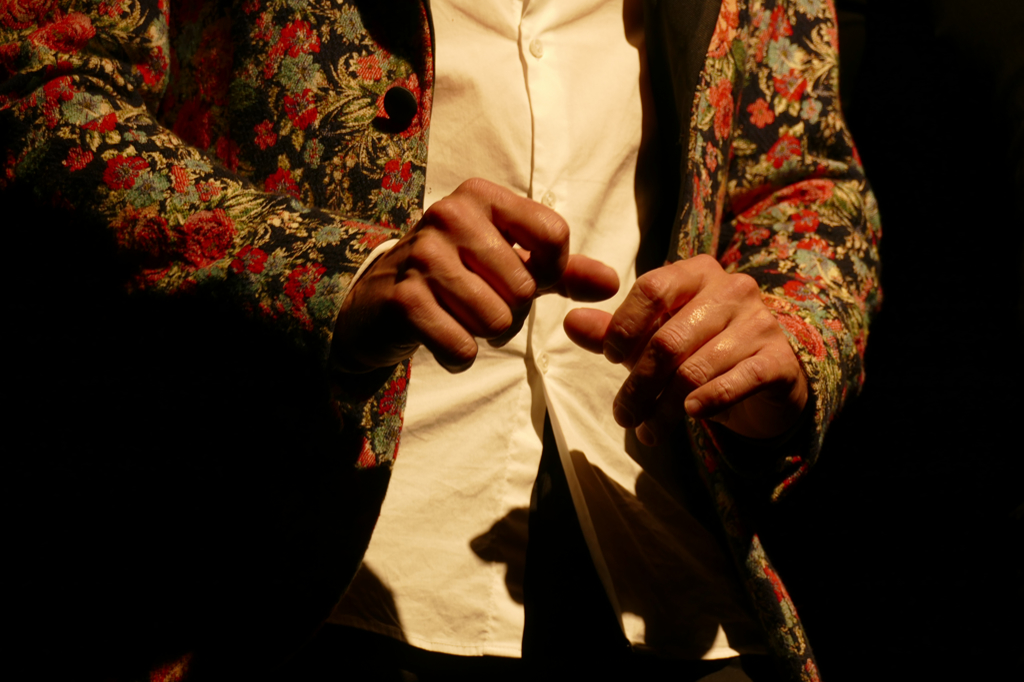
At this joint, everything feels a bit different. More authentic, intimate, and welcoming. From the glass of wine at their small backroom bar to the last clatter on the dancefloor – I had a great evening.

Flamenco shows at Casa Ana take place up to two times per evening, normally at 7.30 and at 9. The best way to book a ticket is through their website. The general entrance is 20 €uros, the show lasts about an hour.
Practical Information
How to Get There
Plane
Granada has a small airport situated about 12 kilometers west of the city center. However, there is only a relatively small number of flights like domestic flights to and from Madrid as well as Barcelona and international connections for instance to Rome and Paris. In general, you might be better off flying into Málaga or even Seville.
To get to the city center, you can catch a bus for 3 €uros. You can buy your ticket from the driver. The bus then takes 50 minutes to the final stop at the Palacio de Congresos. However, the coach has in total twelve stops. For instance, the stop on Calle Gran Vía de Colón right across from Granada’s cathedral is very convenient for many visitors.
The most comfortable option is to take a cab.
Long-Distance Bus
Travelling by long-distance buses is getting really popular in Europe. The cheap prices make up for the little loss of time compared to trains. And since various companies are competing, the service is usually very reliable.
There is a regular bus connection between Granada and Seville, Málaga, Córdoba, Algeciras, and even Madrid. Getting to other places might be possible through Málaga which is a modern and busy hub.
Granada’s central bus station is located about 3 kilometers from the city center. There is a very frequent bus connection.
Train
The train station is actually in the city center. Nevertheless, if you have bulky luggage, you should get there by public bus.
Different types of trains connect Granada with Seville, Córdoba, and Ronda. But you can even travel as far as Valencia and Barcelona. Funny enough, despite the proximity, there is no direct train to Málaga. If you want to go there by train, take the Algeciras train to Bobadilla and change there. Actually, it is easier to travel between Málaga and Granada by bus.
My Tip on Packing
If you are going to Granada – or to any other Spanish city for that matter – you definitely can leave your kitchen sink at home. You simply should travel light which will make your trip smoother and cheaper – at least when you are opting for one of the low-cost airlines that charge extra for basically everything.
I was travelling during wintertime, hence I took a bigger bag to carry more bulky clothes – and I really regretted it. I should have limited myself to hand luggage no matter what. Big luggage is really difficult to pull over those cute cobblestones. And since I stayed at apartments in two places, Cadiz and Málage, I even had a washing machine at my disposal.
How to pack light? That’s easy: Just read my post on Packing Light – Travelling in Style and you’ll be all set. Also, you’re not going to the jungle – there are shops’n’stores everywhere, so in the unlikely event that you’ve forgotten something really important, you’ll be certainly able to obtain it right on the spot.
Next time, I should really listen to my own advice…
How To Get Around
Walking
As in most Spanish cities, driving is not very enjoyable in Granada. You’ll be much better off taking public transportation or walking. Actually, walking is probably the best way to experience the city.
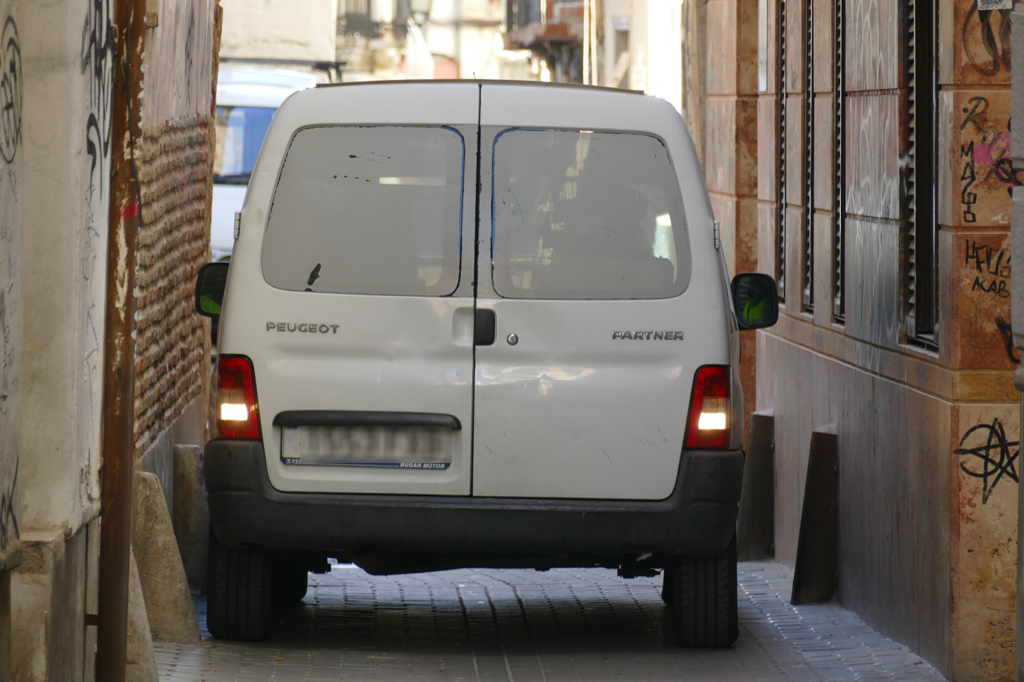
However, in the very center around the Cathedral and in many parts of the Albaicín, streets are often freakishly narrow, short, and winding. Google Maps can be a lifesaver. Unfortunately, it won’t help you with the second problem you might face when walking: the elevation differences. Granada’s mountainous cityscape is absolutely gorgeous, no doubt. But once you have to climb those steep alleys and uncountable stairs, they quickly lose their charm.
Fortunately, there are those small minibusses that take locals and tourists uphill in no time.
By Public Transport
During my road trip through Andalusia, I experienced the best system of public transport in Granada. I stayed close to the Calle Gran Vía de Colón, which locals simply call Gran Vía. Dozens of buses stop alongside this main road and take you basically wherever you need to go. You can check routes and connections conveniently on google maps.
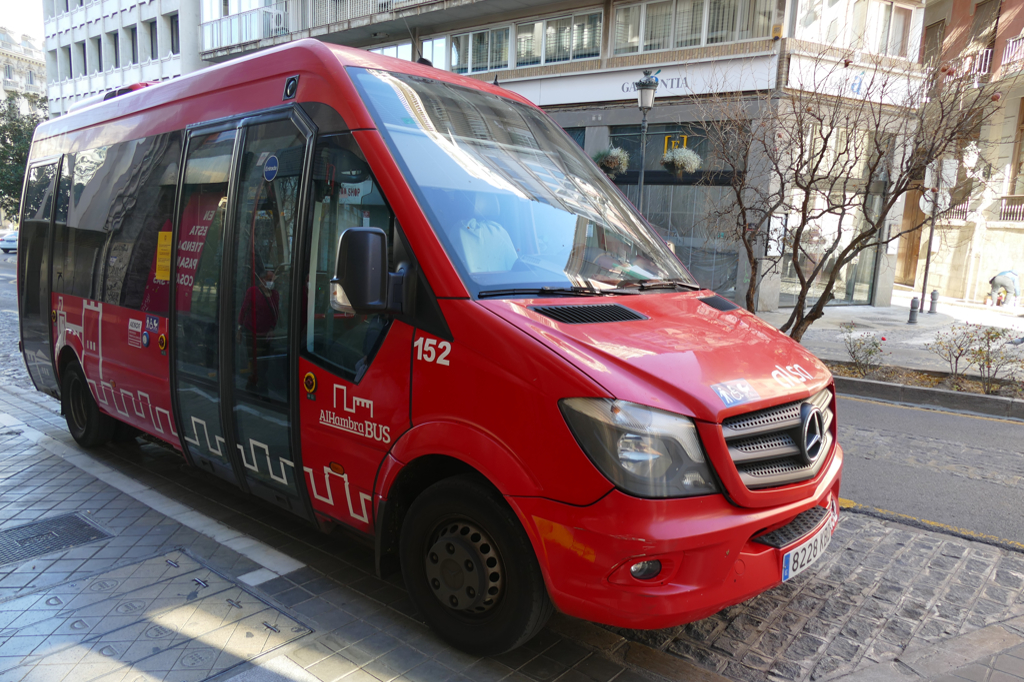
It’s so cool that Granada, in addition to regular buses, has those small red minibusses that can comfortably work their way up to the Sacromonte, the Albaicín, as well as to the Alhambra.
A regular ticket costs 1.40 €uros, but you can obtain a multi-trip card to save money and hassle with your small change. You’ll get 7 trips for 5 €uros, 16 trips for 10, and 33 trips for 20.
If you take the LAC rapid transit bus, you need to buy your ticket from a machine at the stop. On all other buses, you buy your ticket from the driver.
Should you decide on getting the Granada Card, 9 bus trips are included. By buying the card, you’ll get a code that you use to obtain the travel card from one of the machines on Calle Gran Vía de Colón.
There are no fixed timetables, but at major bus stops screens are showing the arrival of the next buses.
Where to Stay
Granada is one of Andalusia’s most visited cities. There is a wide choice of accommodation, many of which are at surprisingly reasonable prices.
I stayed at the small Hotel Reina Cristina* five minutes from the Cathedral. Most importantly, it’s also only a five minutes walk away from one of Granada’s busiest streets, the Calle Gran Vía de Colón. Therefore, not only was I able to simply walk to many places of interest, I also had a wide choice of buses to hop on.
The welcome could have been a teeny bit more cordial, nevertheless, the room was quiet, clean, and very comfortable. And all this for about 50 €uros – I consider that a quite good bargain.
Nevertheless, on this map, you can choose convenient lodging options in Granada according to your needs’n’budget*:
Booking.comWhat to Eat
Tapas are big everywhere in Spain. In Granada, however, they are a vital part of life in a student town since they are such a cheap way of stuffing face. Just about every plaza in town is surrounded by different restaurants.
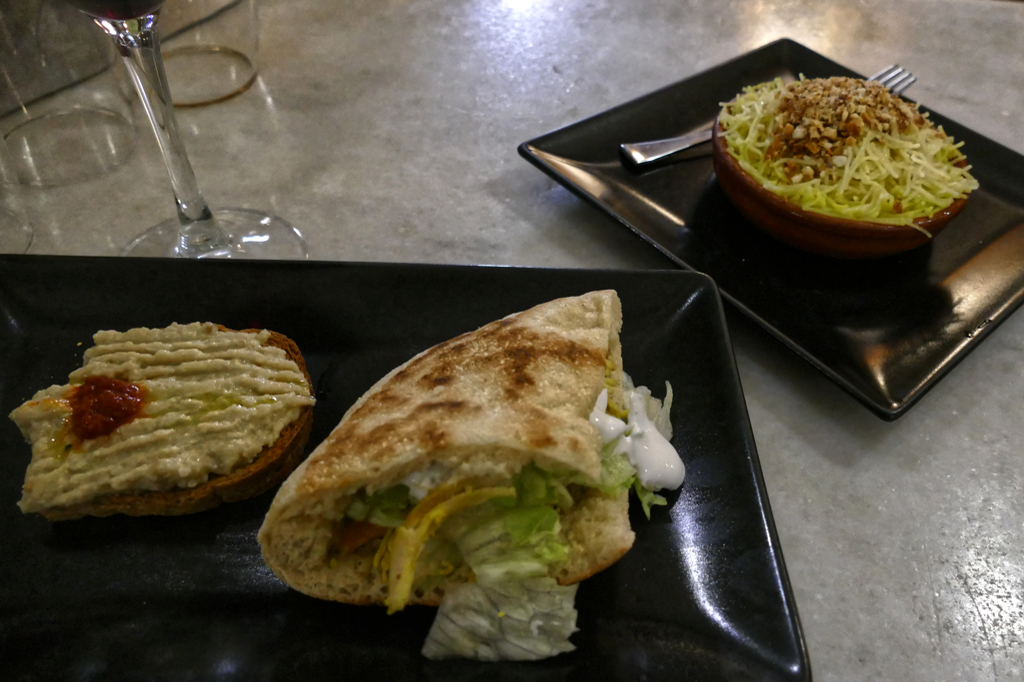
And while traditional tapas can be the Spanish potato omelet tortilla española, slices of serrano ham, diced cheese, olives, small sandwiches, a blob of ensalada rusa, potato salad with mayonnaise, in Granada, they take this eating culture to a whole different level by giving the classics an oriental twist.
Whereby, let’s face it, traditional oriental mezze easily qualify as tapas, hence, this fusion isn’t such a crazy stretch.
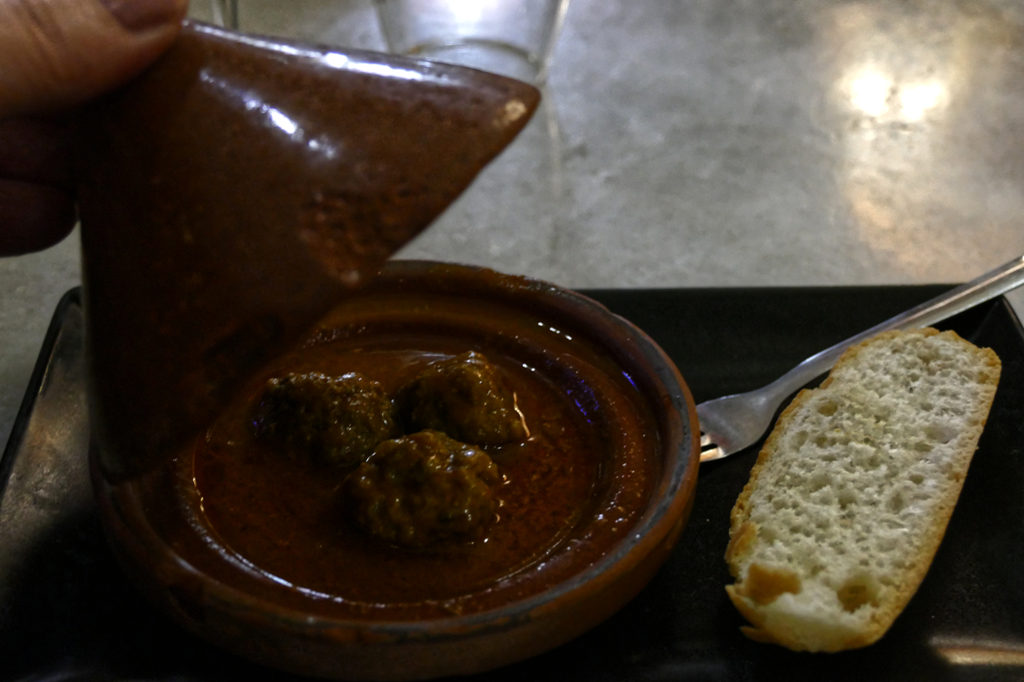
Howsoever, if you want the best of the best, venture into the Calle Jardines and try to get one of the few seats at Om Kalsum. Here, the food is fantastic and since they are catering mainly to the young crowds, prices are low and the ambiance is friendly and relaxed. That they are also serving alcohol might be another asset.
Breakfast
It’s probably due to the mild climate that Spanish people tend to turn their kitchen off and enjoy their meals at the uncountable cafés, bars, and restaurants. And this starts at breakfast.
There are many small bakeries and delis selling all kinds of sandwiches and empanadas. If you have a sweet tooth, you’ll also find a great variety of delicious pastries.
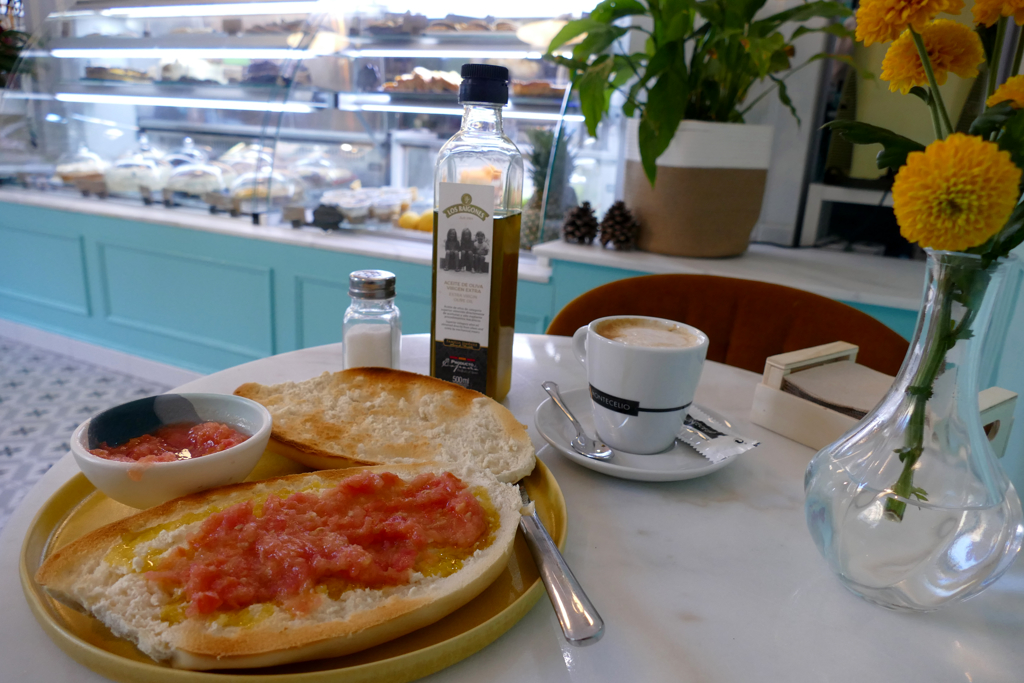
Therefore, if your hotel does not offer any breakfast, just enjoy your morning coffee at one of Granada’s many bakeries, rubbing shoulders with the locals.
You’ll find the best ones between the Plaza Isabel La Católica and the Plaza Nueva as well as along the Calle Gran Vía de Colón. This is then also the perfect starting point for your visit – no matter if you intend to explore walking or if you need to catch a bus.
Cash and Cards
Until now, 20 European countries replaced their former local currency with the €uro starting in 2002. Obviously, Spain is one of them. The exchange rate is 1 US$ = 0.94 EUR as of January 2023. However, you can check today’s conversion rate on this page.
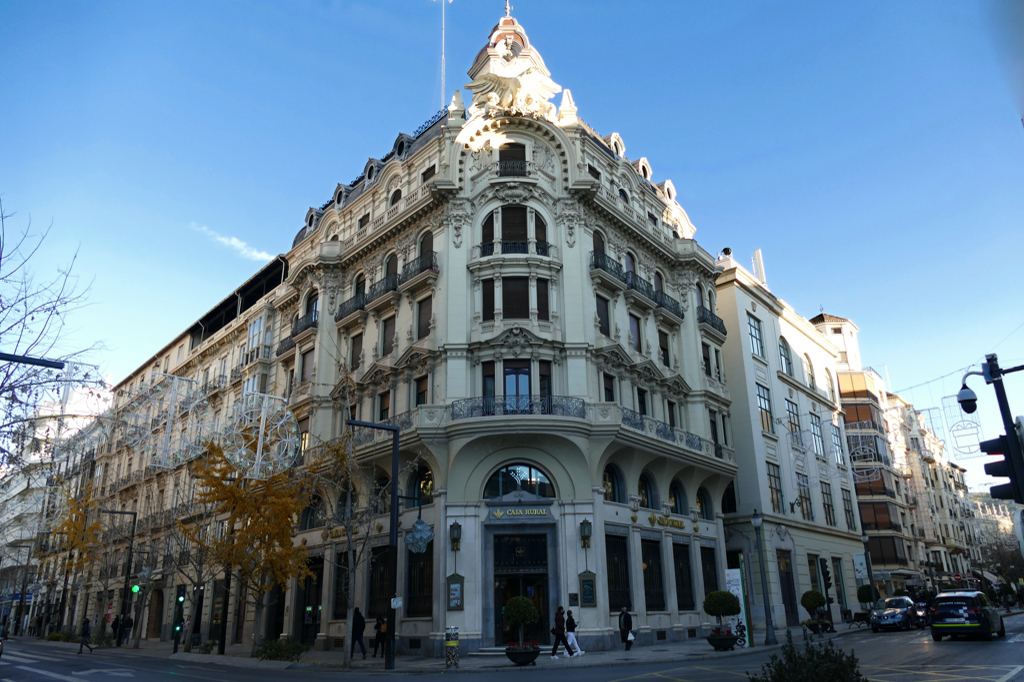
Especially due to the Covid pandemic, even small businesses prefer that you pay by credit card, even small amounts – and preferably contactless. I could have actually done my entire road trip without spending one cent cash – apart from one tea room in Córdoba.
Granada Card
Of all the tourist passes I got, the Granada Card was the only one that really paid out. Especially since a visit to the Alhambra is not only included. You also make a reservation at the Nazdid Palace as you are booking. This saves you some hassle especially during high season, obviously. Apart from the Alhambra, the pass includes the entrance fee to other main monuments and museums as well as 9 trips on the urban bus. However, you have to get this ticket using a code on your pass at one of the ticket machines that you find along the Calle Gran Vía de Colón.
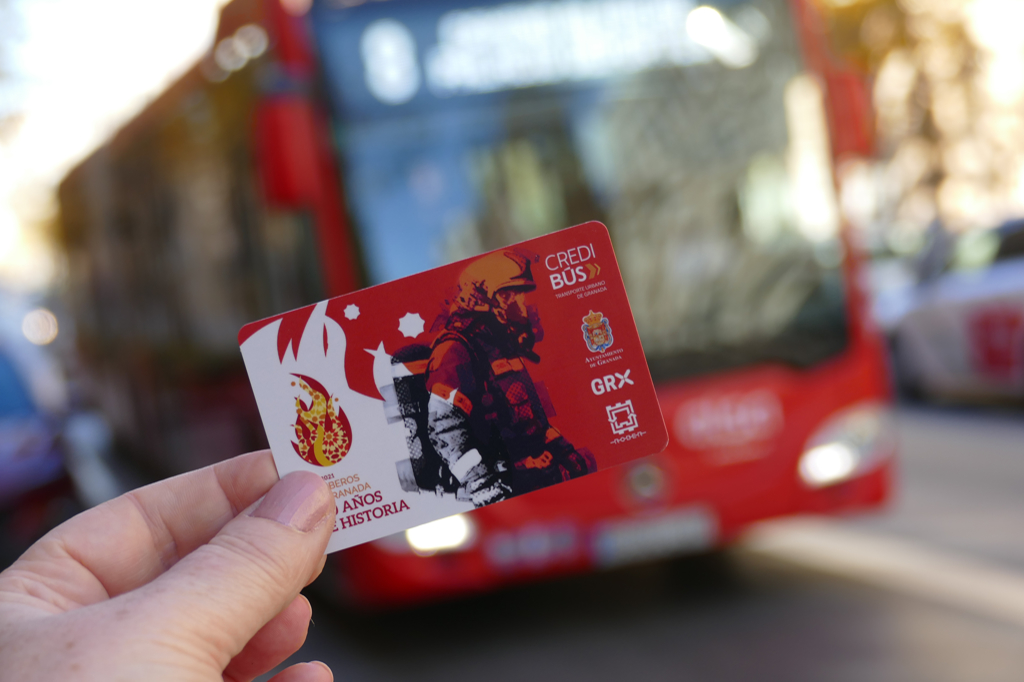
To make things a bit more complicated, there are actually seven different plans. The most simple one is the above which sets you back 40 €uros and is only worth it if you spend two entire days in the city. For an additional 3 €uros, you get to see some of the old Moorish structures like the Bañuelo, the Corral del Carbón, and others. Then, there are various versions of nocturn visits to the Alhambra and finally a city pass that does not include the Alhambra.
To check out which plan works best for your trip, have a look at their website – and keep in mind that you might spend more time than you expect at the individual places so you won’t be able to use the card to its full extent.
At least I wasn’t. At the end of the day, I paid approximately the equivalent of the individual entrance fees, however, the card saved me time and hassle.
Connection and Communication
Since June 2017, no roaming charges apply within the EU with a European mobile phone contract, This applies in all 27 countries of the European Union as well as in Iceland, Liechtenstein, and Norway and to all contracts.
In case European roaming is not available, you can connect to the internet without any issue at basically every museum, eatery, or café, and, of course, hotel.
If you insist on being online 24/7, you can get a SIM card, obviously. The cheapest one would be Lycamobile while Orange Tu Mundo has the widest coverage.
In Spain, they use plug types C and F. Their voltage is 230 V and the frequency 50 Hz. Whereby, as nowadays, all these chargers have integrated adapters, in general, the voltage and frequency don’t really matter.
By the way, you’ll find this information and many more comprehensive travel tips in my post World’s Most Complete Travel Information – an indispensable globetrotter-classic.
Language
Granadinos speak an Andalusian dialect, the so-called Andaluz. Interestingly, it has a lot more Arabic influences than standard Spanish. Even if you speak the standard Castellano well, you may need a bit to get used to it. Obviously, locals make an effort so that visitors understand them better.
Since Granada is a student city, there are many young people that speak English quite well. Also, people working in tourism have at least an okay command of the language.
However, if you want to learn some basic Spanish or just brush up on your knowledge, there are various apps and online tools. I personally like to practice with babbel.
Nevertheless, here are some ground rules for Spanish pronunciation since saying for instance city names wrong can cause some problems.
Say It Right
In general, you read Spanish the way it’s written. Although, the letter C is a bit tricky for foreigners. Placed before an A, O, or U, it’s hard and pronounced as K. Followed by E or I, it is pronounced like an English the. Now, if you want that th-sound in combination with A, O, or U, the letter Z comes in the picture.
Therefore, it’s Plaza de San Nicolas with a Z, but Placeta de San Miguel Bajo with a C.
On the other hand, if you want C to sound hard in combination with E or I, you make it a QU – but again, you don’t hear the U. Fine example: Tequila, that you pronounce like Tekkila.
This applies also to the letter G. If it’s followed by A, O, or U, it’s pronounced like the G in guitar, hence, hard. This is also the perfect example of how to make a G sound hard before an E or an I: They squeeze in a mute U. On the other hand, if it stands before an E or an I, it is rather breathed than pronounced – a bit like the H in house. As I explained above, the famous Gardens are pronounced Heneralife.
The same applies to the letter J. You always pronounce it like the H in house. If you speak for instance German, Flemish, or Czech, you get even closer by pronouncing it like a CH in echt.
A last trap is double L which is not pronounced like an L but like a Y in yellow. So the mirador is not pronounced Sila del Moro, but Siya. However, don’t overdo it. When a word is written with just one L like Tequila, it’s a simple and innocent L.
Alone No More
Yes, I’m an independent, avid solo-travelling woman. However, I recommend joining a guided tour at times. Especially if you visit Granada during high season or if you have just a very short period of time, an organized tour will take you to all the most important sites in an efficient yet comfortable way.
Therefore, here are some great ideas of which tours to join*:
Map
This map should help you to find all those iconic places I’m introducing in this post.
Granada was only one of many amazing places I visited during my road trip through Andalusia. To read about the others, go to the main post and take your pick! There, you’ll also find further valuable general information that will make your own trip much smoother and more enjoyable.
Pinnable Pictures
If you choose to pin this post for later, please use one of these pictures:
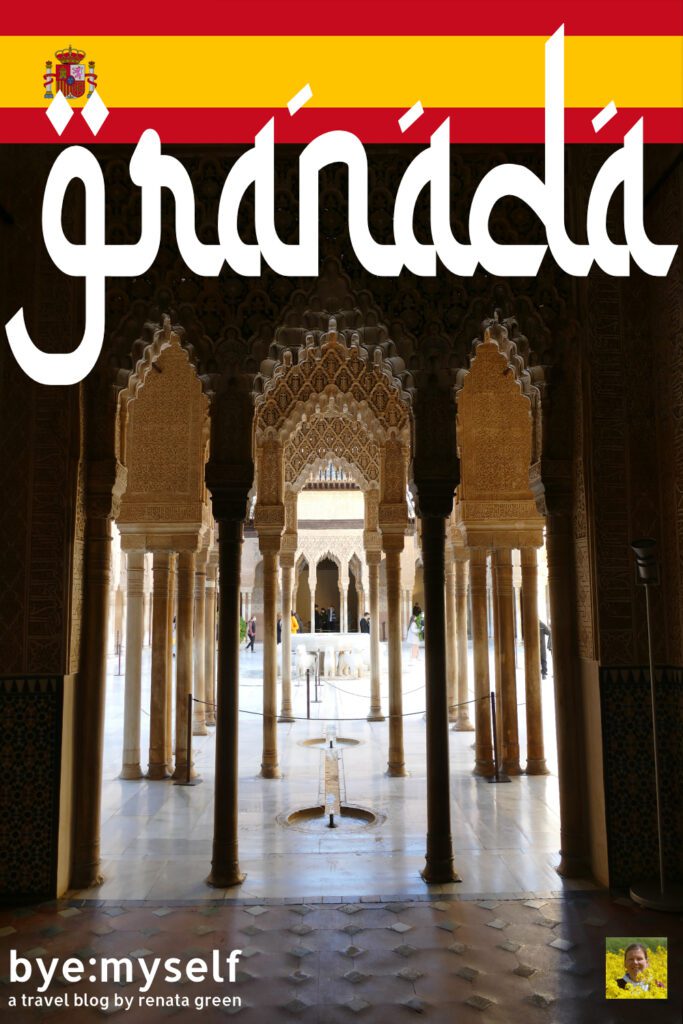
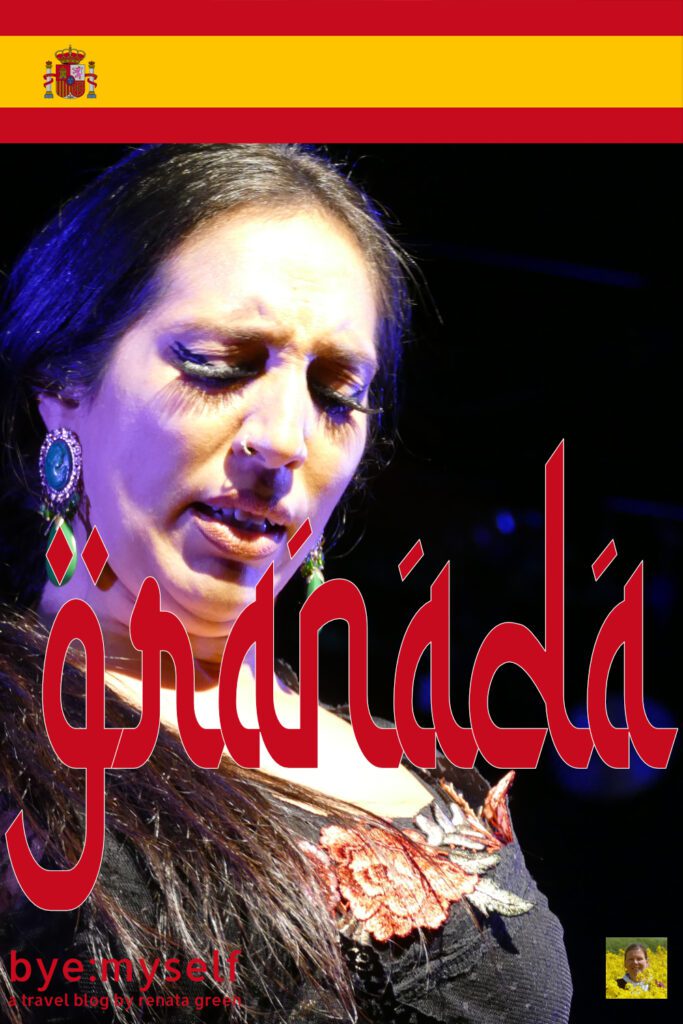
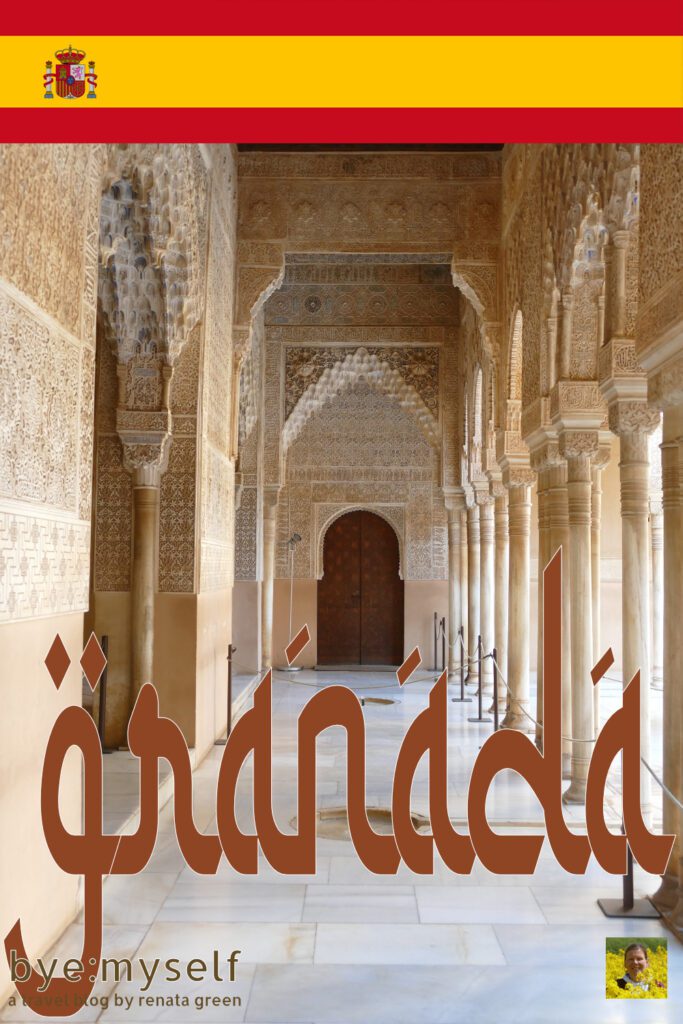
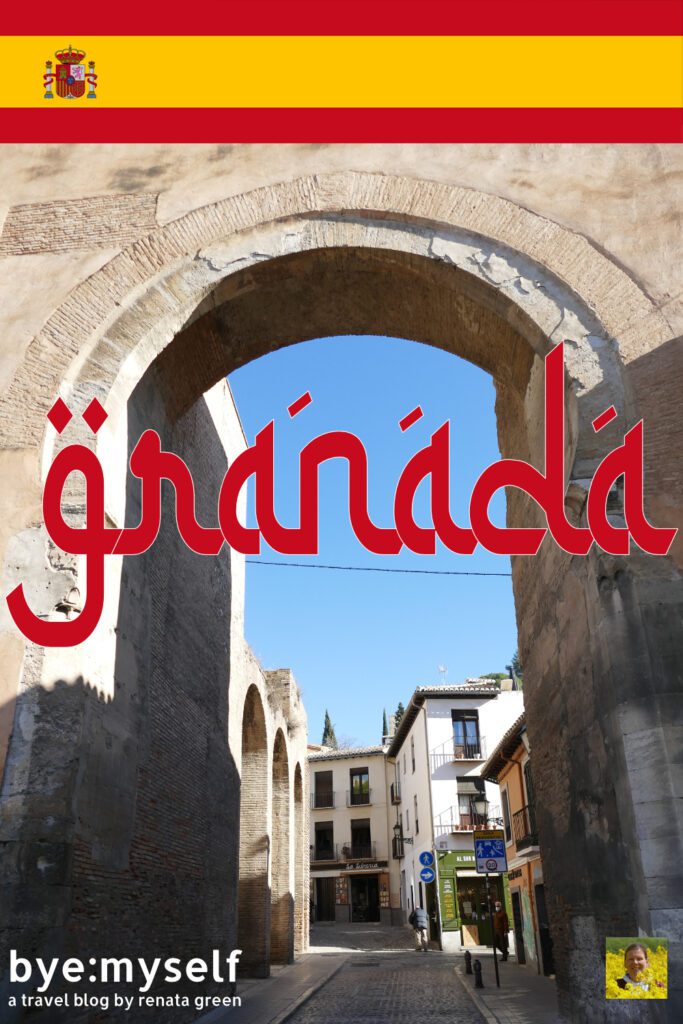
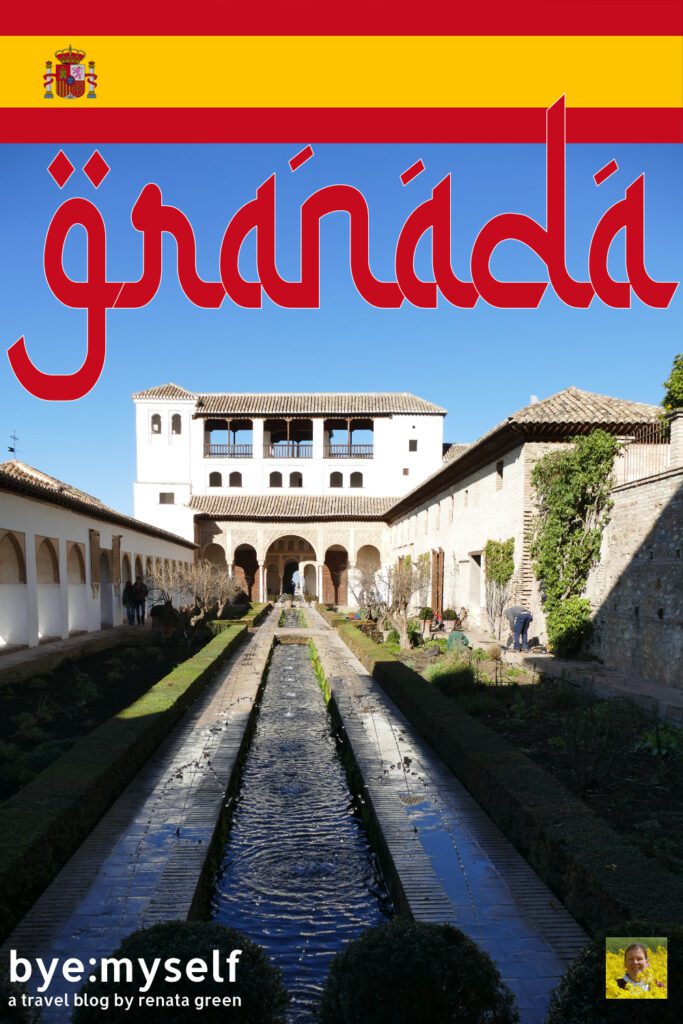
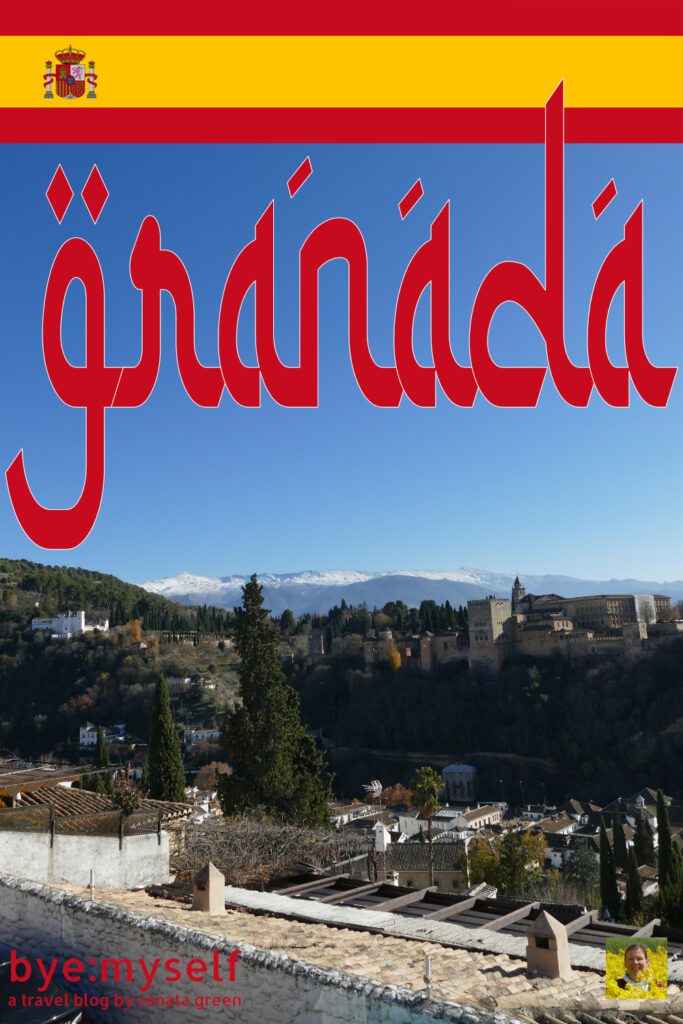
Note: I’m completing, editing, and updating this post regularly – last in January 2023.
Did You Enjoy This Post? Then You Might Like Also These:
GARACHICO – ICOD DE LOS VINOS – MASCA – Touring Tenerife’s Delightful Northcoast
Guide to CADIZ – the oldest city in Europe
Day Trip to the DUNAS DE MASPALOMAS and PUERTO DE MOGAN
Best Street Art in MALAGA
A Visit to the Colonia Güell – Where Eusebi Güell Created His Universe
Best Things to do in TENERIFE – one week on a microcontinent
One Week in MALLORCA – Guide to the Island’s Mesmerizing Hideouts
LA OLIVA – Fuerteventura Like in Ye Olden Days
* This is an affiliate link. Hence, If you book through this page, not only do you get the best deal. I also get a small commission that helps me run this blog. Thank you so much for supporting me!

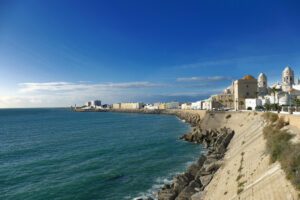
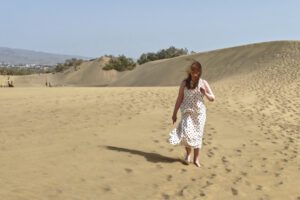
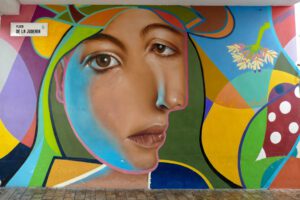
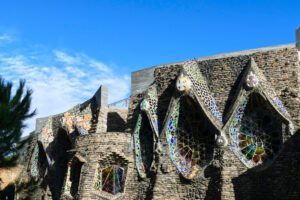

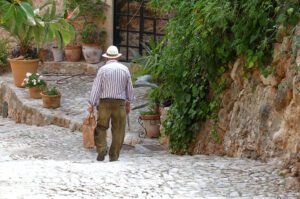
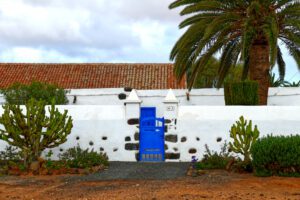
What an amazing post about Granada. Very complete and historically documented. Granada is my hometown and I can say you have written a great summary of what one can see in there. I will send your post to my visitors friends. Thanks a lot
Gracias para su comentario tan amable 🙂 I simply loved Granada and I hope I can visit again anytime soon!
Omg, I went to Granada on a day trip so we just saw Alhambra and Generalife. There is so much more to see in this university town! Should have studied here!
Hey, it’s never too late 😉
I loved Granada. I wish I was able to spend more time in this city during my last trip! The Moroccan influence here is beautiful. I enjoyed eating at many Moroccan restaurants and walking down the Moroccan corridor. I think I need to make a trip and check out the recommendations you mentioned here!
One of my bucket list of places to visit. Question though, why are your photos so amazing and mostly has no crowd of people in it? Is it because you take them just like that? I just envy your photography skills + how you travel a LOT, wish I can too very soon!
First of all, thank you sooo much for complimenting me on my photos 🙂 There aren’t crowds because I went to Andalusia during off-season beginning of December – and during covid 🙂
The church layout of Monasterio de Nuestra Señora is comparable to that of the Sistine Chapel. It’s stunning! I think I’d cry if ever I visit Granada – which, I definitely will. Everything on this place is exactly what my wanderlust self craves to visit.
It’s funny how many people think that way. Yes, it’s much smaller, however, as beautiful as the ‘big sister’. 😀
The chapel looks absolutely breath-taking!! But there are some other beautiful buildings as well.
Do you mean the Cartuja? That was actually my favorite site – despite the Alhambra 😉
Wow, I never knew there was so much great beauty in Granad! I am so happy that you introduced me to Andalusia!
This is amazing, the place looks cool and would love to visit it and check these amazing areas.
We almost skipped Granada after we got a bit unsettled when we were robbed in Madrid. But we pushed on and were so glad we got to see Granada. It was one of our favourite stops on that trip. Sadly we only had 2 days and we missed so many of the gems you found. Even one day at Alhambra was not enough. Great reasons to go back.
I also totally underestimated the time you spend at the Alhambra – and although I was pacing like a maniac, there are still sooo many sites I didn’t get to see, can you believe it?! 😀
I love how you display the beauty AND provide so much history! The Alhambra crowns are stunning!
Thank you, I’m glad you like the post 🙂
Wow, Granada indeed is a beautiful place. The views are breathtaking. If I have a chance to go there, I would probably take a lot of pictures.
Yes, I really had to control myself to not get overboard 😉
It has been years since I visited Spain and this post brought back so many beautiful memories. Your photos are absolutely gorgeous. I cannot wait to go back to Spain one day. Thank you for such a detailed account of Granada.
Ah, I’m glad to have taken you down memory lane 😉
This is somewhere I would really love to visit. Granada is supposed to be lovely. I’d love to see a flamenco show when we visit.
The show I saw was just amazing – very recommended 🙂
The place looks amazing! It’s such an unusual mix of different styles and cultures. I didn’t think of Granada much when I thought of travels but now I think I might have been wrong about it. Definitely needs a closer look. It’s that my friend Malaga never said much about the beauty of her home.
It was actually far more varied than I expected 🙂
by the way, do you have a suggestion on how much time to spend there for stress-free enjoyment? 3 days, I gather, should be enough for a start?
Stressfree…in all honesty, I’d even say 5 days. However, in three full days, you’ll get to see lots of the best sites and landmarks 🙂
I would definitely want to visit The Sanctuary. With the paintings on the ceiling, it reminds me a bit of the Sistine Chapel.
Totally! It’s much smaller, but equally amazing 🙂
I’ve never heard of it, but it looks like a gorgeous spot to visit! Thanks for sharing all of this info 🙂
Granada is one of my favourite places in Spain, and reading this brings back great memories. I’ve missed so many great places in and around Granada and clearly need to return again soon. A very detailed guide and with great history too!
That’s my problem after each and every trip: I realize how much I’ve missed although I’m running around like a maniac all day 😀 😀
I love the sculpture of the last super. Your photos are amazing. I would love to go there.
Thank you – glad you like the pix 🙂
Many years ago during a trip to Spain, I visited Granada. Due to timing, we were not able to see a lot of the attractions. Our main stop was the Alhambra. I see now why, since it is one of the top attractions. Although spectacular, we clearly missed many more beautiful locations. Maybe it is time to plan another trip to Granada. Your photos present an amazing visual. Thank you for sharing those and all of the information.
That’s what easily could have happened to me: I thought there was the Alhambra and that was basically it. At the end of the day, I found other landmarks at least as impressive.
The Royal Chapel looks stunning! I would definitely want to visit it. I also love the architecture of the Alcaiceria. Those tapas look yummy!
Yes, there are many great things to see – and to eat 😀